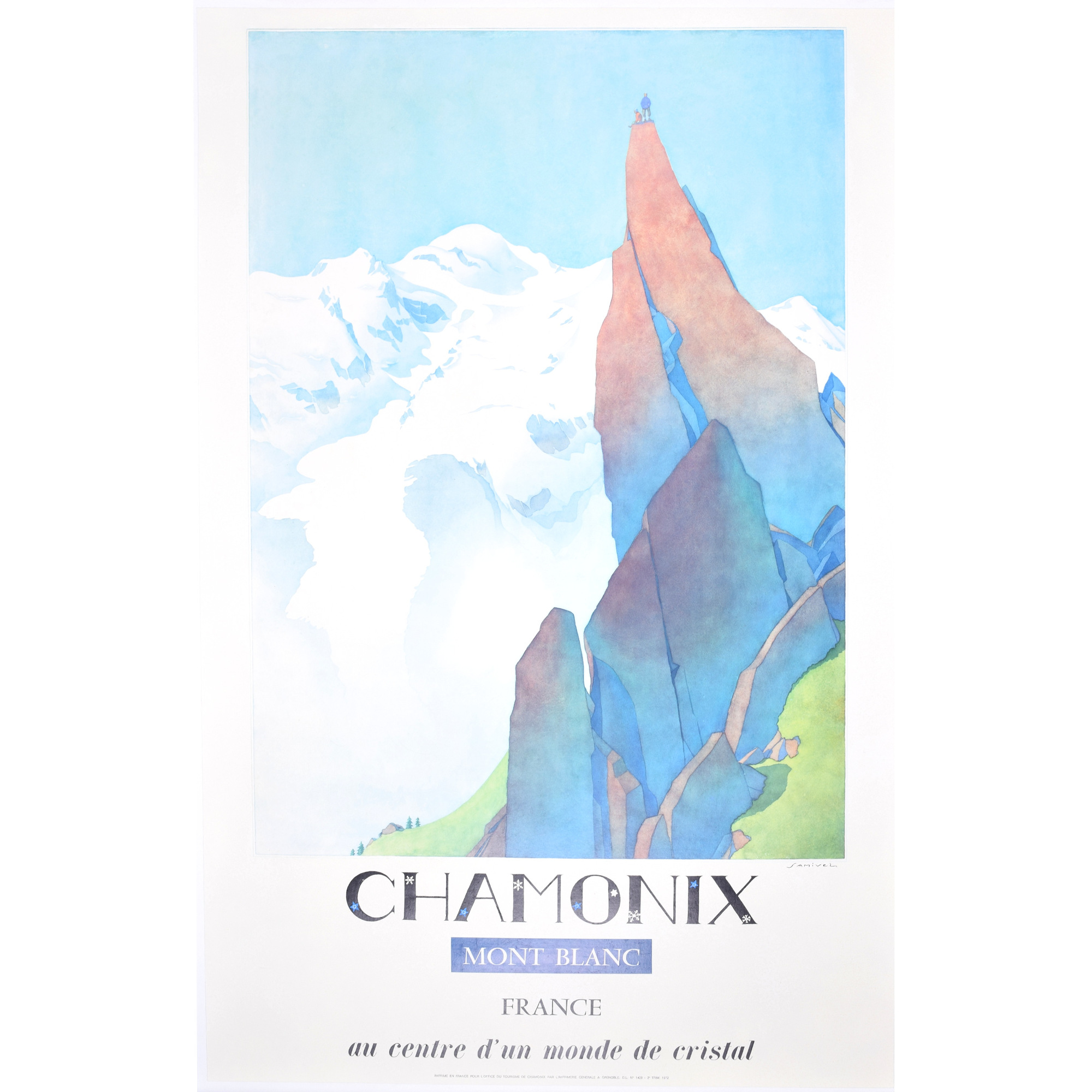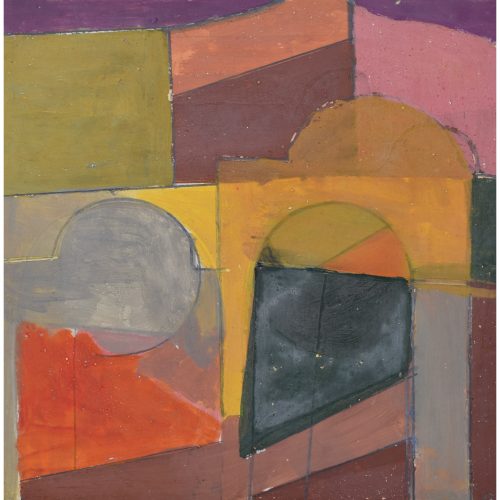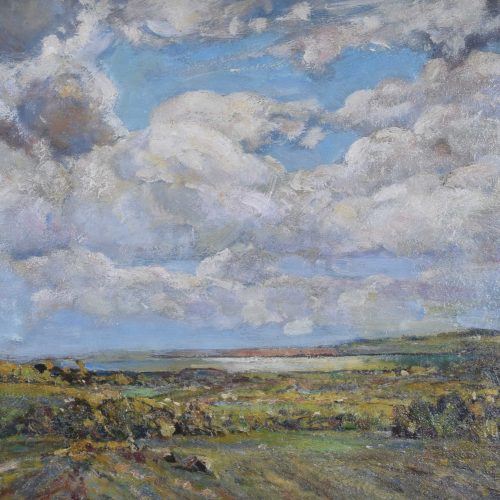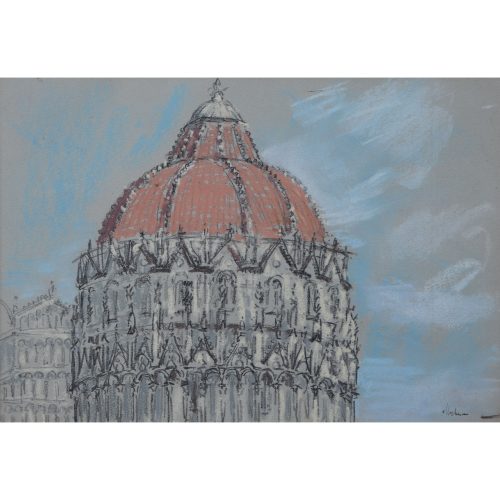-

'Samivel' Paul Gayet-Tancrède (1907-1992)
Du Léman à La Méditerranée, La Grande Traversée des Alpes Françaises
('From Lake Geneva to the Mediterranean, La Grande Traversée of the French Alps') Imprimé en France - Printed in France 1975 Original Vintage Ski Poster 99x62cm Condition: excellent With the ever-popular topic of mountains for climbing and skiing, Samivel here draws a snow-covered col in the mountains. La Grande Traversée is a long-distance walking route from Thonon les Bains to Nice, set up in the early 1970s. Samivel was a writer, an artist, a photographer, an explorer and more. In 1948 he accompanied Paul Émile Victor on the first French Greenland expedition, making three documentary films in the process. His friends included Théodore Monod and Gilbert André - the latter the mayor of Bonneval-sur-Arc and one of the founders of the Vanoise National Park - and with them and others he spent his whole life aiming for the protection of the imperilled countryside. The graphic artist side of him had a life-long fascination with high mountains, and his illustrated books and series of posters of the French Alps have long been popular. Click here to see other posters by Samivel. If you are interested email info@manningfineart.co.uk or call us on 07929 749056. -
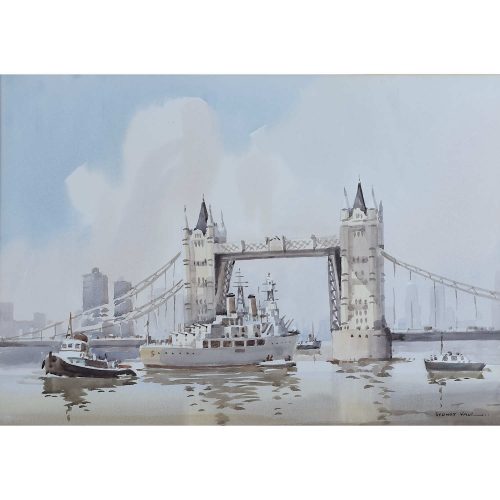
Sydney Vale F. R. S. A. (1916 - 1991)
A warship passing under Tower Bridge
Watercolour 35 x 50 cm Born in 1916, Sydney Vale was a Fellow of the Royal Society of Arts and a member of the prestigious Wapping Group of Artists from 1972 to 1991, which was formed primarily to record life in London's Docklands. Within this group, Vale and his contemporaries specialised in portraying the charm and romance of the River Thames from source to estuary. -
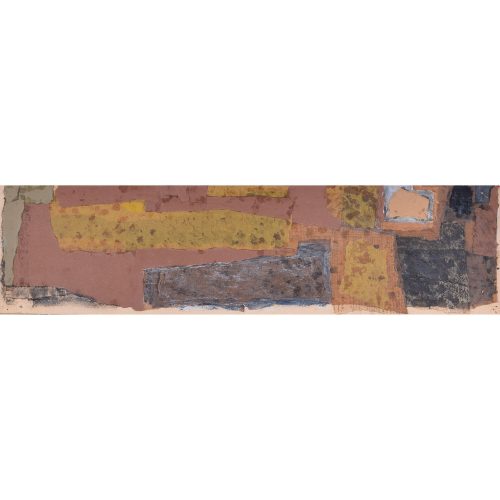
Clifford Ellis (1907-1985)
Collage I
Collage 13x56cm Click here for biographical details and other works by the artist If you are interested email info@manningfineart.co.uk or call us on 07929 749056. -
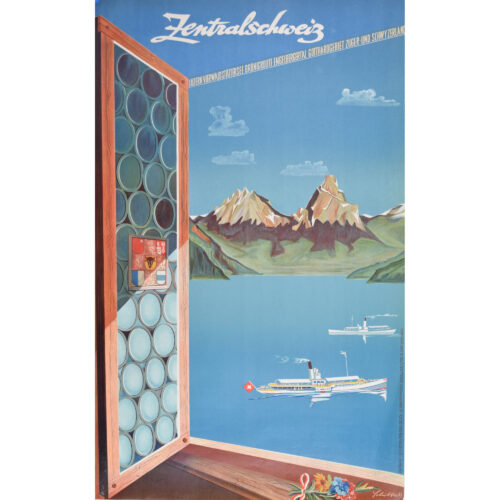
Hans Schilter (1918 - 1988)
Zentralschweiz (1951)
Original vintage poster 102 x 64 cm This marvellous poster encourages travel to Central Switzerland - a land of gently snow-capped mountains and wide blue lakes. Hans Schilter was a Swiss artist known for his poster designs. Condition: generally very good; a few repaired short edge tears and small repaired missing area approx 2cm x 1 cm top left corner. If you are interested, please email info@manningfineart.co.uk or call us on 07929 749056. Click here for other original vintage travel posters. -
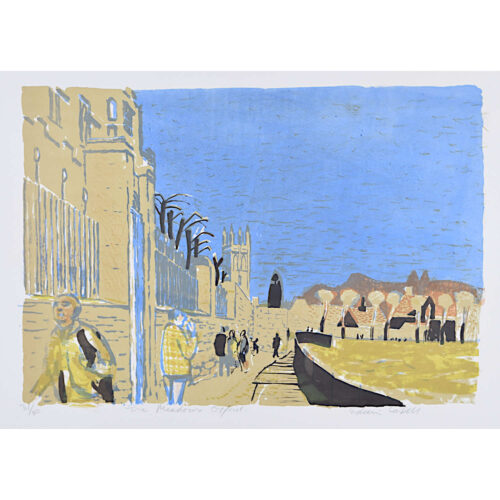
Edwin La Dell (1914-1970)
The Meadows, Oxford
Lithograph 40 x 55 cm Signed, titled, and numbered 31/80 in pencil. A bright blue winter sky looks over Christ Church Meadows, complete with pedestrians waltzing down Deadman's Walk. La Dell studied at the Sheffield School of Art, where he won a scholarship to the Royal College of Art. From 1934 to 1940 John Nash was the head of printmaking there, and taught La Dell. La Dell himself became head of lithography there in 1948, and remained in post until his death. During the war La Dell was an official war artist and a camofleur, but he is probably best known for his lithographs of Oxford and Cambridge that he published himself. His works are widely held in the public collections, including the Royal Academy and the Government Art Collection, the latter of which holds many of his views of Cambridge. Condition: very good. Backed to linen. If you are interested, please email info@manningfineart.co.uk or call us on 07929 749056. Click here for other views of Christ Church. -
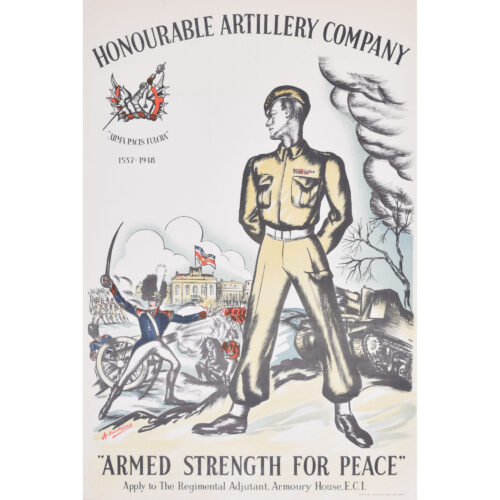
Anna Zinkeisen (1901 - 1976)
Honourable Artillery Company: Armed Strength For Peace
Original vintage poster 75 x 51 cm ""ARMED STRENGTH FOR PEACE": Apply to The Regimental Adjutant, Armoury House, E.C.I." Anna Zinkeisen won a scholarship to the Royal Academy Schools in 1916, focusing on sculpture and exhibiting at the Royal Academy in 1919. She was awarded the Landseer Award in 1920 and 1921, and went on to become an esteemed portrait artist, often of society ladies. She produced a series of posters for London Transport in the inter-war period. During the Second World War, Zinkeisen became a nurse, and was profoundly affected by the suffering she saw during her time working in St Mary’s Hospital. This is arguably the point at which she and her sister Doris reached the pinnacle of their careers, producing some of the finest and most affecting depictions of the world at war made during this period. Condition: generally very good, slight edge wear top right and one soft crease into the tank. If you are interested, please email info@manningfineart.co.uk or call us on 07929 749056. Click here for other original vintage World War II posters. -
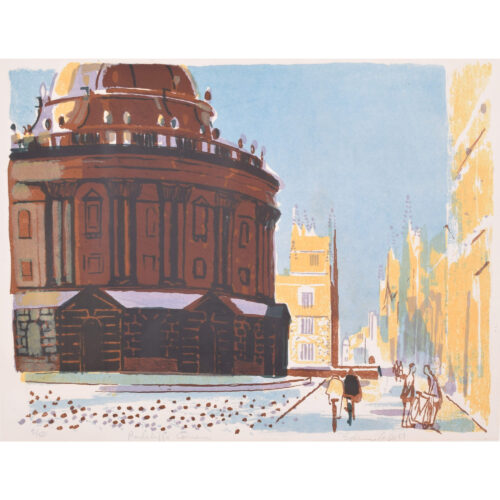
Edwin La Dell (1914-1970)
The Radcliffe Camera, Oxford
Lithograph 41 x 54 cm Numbered 2/50, titled, and signed below in pencil. Radcliffe Square in autumn shades. The Radcliffe Camera dominates the lithograph, and La Dell expertly captures the afternoon sun on the golden stone of Brasenose and the University Church. Students cycle towards the High. La Dell studied at the Sheffield School of Art, where he won a scholarship to the Royal College of Art. From 1934 to 1940 John Nash was the head of printmaking there, and taught La Dell. La Dell himself became head of lithography there in 1948, and remained in post until his death. During the war La Dell was an official war artist and a camofleur, but he is probably best known for his lithographs of Oxford and Cambridge that he published himself. His works are widely held in the public collections, including the Royal Academy and the Government Art Collection, the latter of which holds many of his views of Cambridge. Condition: generally very good. Fractional age-toning to paper; old glue marks to margin which will be under the mount when framed. If you are interested, please email info@manningfineart.co.uk or call us on 07929 749056. Click here for other general views of Oxford. -
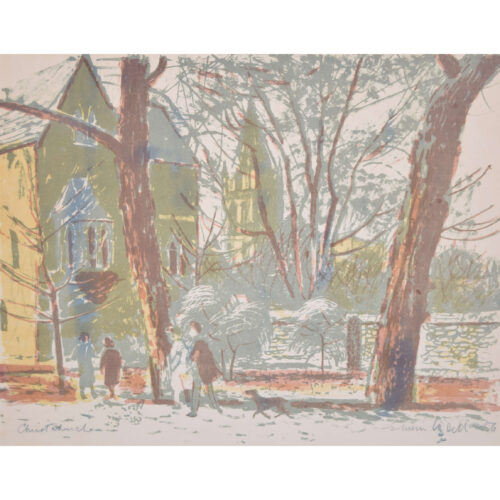
Edwin La Dell (1914-1970)
Christ Church, Oxford (1956)
Lithograph 33 x 42 cm Signed and dated lower right. With invoice from Royal Academy and letter from the artist. This view of Christ Church from the meadows is rendered in a muted palette, suggestive of a late autumn afternoon. Four coat-and-hat-clad pedestrians stroll along, accompanied by small child and dog. La Dell studied at the Sheffield School of Art, where he won a scholarship to the Royal College of Art. From 1934 to 1940 John Nash was the head of printmaking there, and taught La Dell. La Dell himself became head of lithography there in 1948, and remained in post until his death. During the war La Dell was an official war artist and a camofleur, but he is probably best known for his lithographs of Oxford and Cambridge that he published himself. His works are widely held in the public collections, including the Royal Academy and the Government Art Collection, the latter of which holds many of his views of Cambridge. Condition: mounted to board. Slight but even age toning. If you are interested, please email info@manningfineart.co.uk or call us on 07929 749056. Click here for other views of Christ Church. -
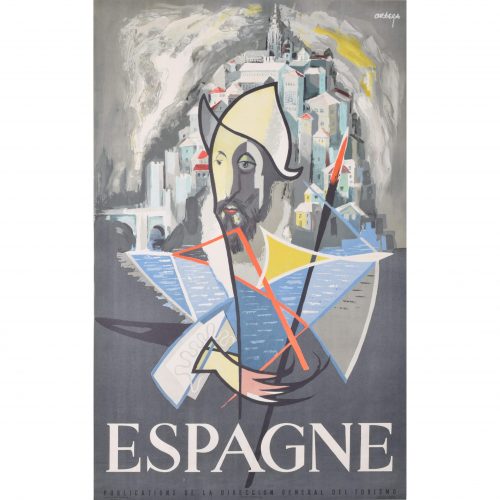
José Ortega (1921 - 1990)
"Don Quixote" Espagne
Original vintage poster c. 1960 99 x 65 cm Printed in Barcelona for the Publications de la Direccion General del Turismo. Ortega's poster is an abstract depiction Don Quixote (the Spanish hero written by Miguel de Cervantes), complete with his distinctive hat and spear. Ortega designed the poster for the Spanish tourist board, using an illustrious figure from Spain's literary heritage to encourage people to visit Spain. José García Ortega was born in Arroba de los Montes and was a member of the Communist Party. He worked as a painter and sculptor, studying at the Círculo de Bellas Artes in Madrid. In 1953 he went to France to study art, funded by a French government scholarship. He returned to Spain throughout the 1950s and 1960s, and became a commercially successful artist. Some of his most famous designs include the posters which the Spanish tourist board commissioned from him circa 1960. Condition: generally very good. If you are interested, please email info@manningfineart.co.uk or call us on 07929 749056. Click here for more original vintage travel posters. -
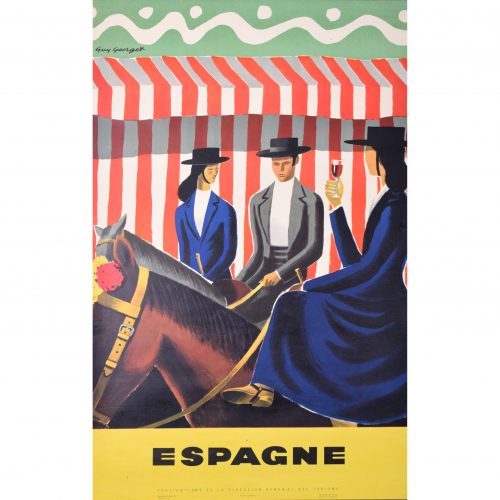
Guy Georget (1911 - 1992)
Espagne - Riders
Original vintage poster 100 x 62 cm One of Georget's fantastic posters designed for the Spanish tourist board. Three riders in traditional dress, with the ladies riding side-saddle, and one with sherry in hand, pose mounted in front of a red and white striped background. The bold, bright colours make the poster typically Georget. Guy Georget was a commercial designer; most of his poster designs were published in the late 1940s. Hired by the tourist boards in their post-war spree of tourism encouragement, Georget designed posters influenced by the styles of Pablo Picasso and Georges Braque. Condition: generally very good; a few tiny repaired edge tears. If you are interested, please email info@manningfineart.co.uk or call us on 07929 749056. Click here for more original vintage travel posters. -
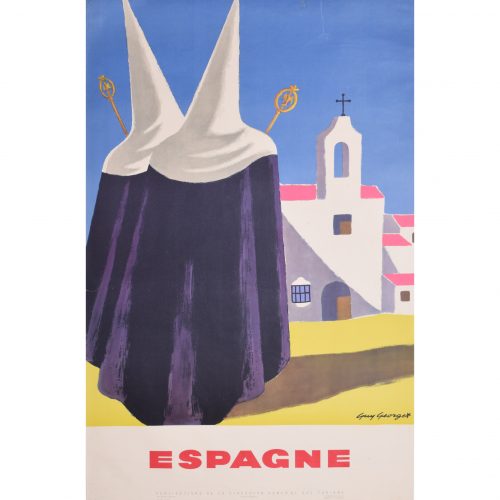
Guy Georget (1911 - 1992)
Espagne - Pilgrims
Original vintage poster 100 x 62 cm One of the fantastic posters Georget designed for the Spanish tourist board. Two pilgrims progress towards a typically Spanish church; Georget makes uses vibrant tones of bright blue, pink, and yellow to illustrate the scene. Guy Georget was a commercial designer; most of his poster designs were published in the late 1940s. Hired by the tourist boards in their post-war spree of tourism encouragement, Georget designed posters influenced by the styles of Pablo Picasso and Georges Braque. Condition: generally very good; a few repaired edge tears including one at the top c. 80mm, one to left side c. 25 mm. If you are interested, please email info@manningfineart.co.uk or call us on 07929 749056. Click here for more original vintage travel posters. -
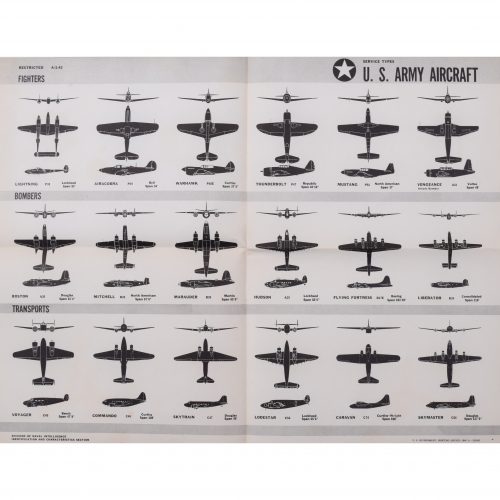
1943 Army World War II USA (1942)
Original aeroplane recognition poster 44 x 59 cm A summary of US aeroplanes from the series of US Navy identification posters that we have in stock. Fighters: P38 Lightning; P39 Airacobra; Curtiss P40E Warhawk; P47 Thunderbolt; P51 Mustang; A31 Vengeance. Bombers: A20 Boston; B25 Mitchell; B26 Marauder; Lockheed Hudson; Boeing B17E Flying Fortress; B24 Consolidated Liberator. Transports: C45 Voyager; C46 Commando; C47 Douglas Skytrain; Lockheed Lodestar; C76 Caravan; C54 Douglas Skymaster. Condition: generally very good, occasional handling marks. Folds as issued. If you’d like to know more, please email info@manningfineart.co.uk or call us on 07929 749056. -
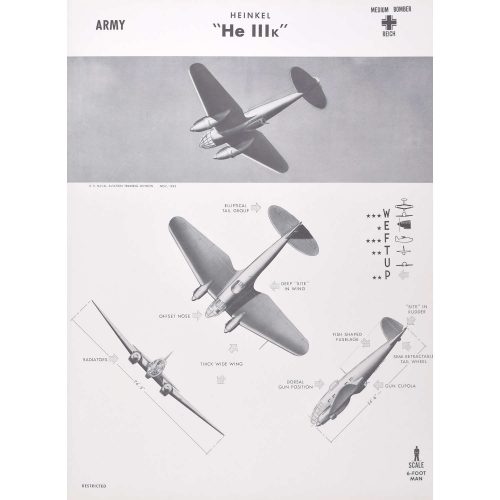
Heinkel "He 111K"
Aeroplane identification poster, published 1942 63 x 47 cm A particularly unusual style of aeroplane identification poster, owing to the very arty images. Most such posters rely on very plain silhouettes, this series - and we have several in this series; view them here - have a much more arty approach to the task with shading and an interesting angle view. The Heinkel He 111 was a German bomber aircraft designed by Siegfried and Walter Günter at Heinkel Flugzeugwerke in 1934. Through development it was described as a "wolf in sheep''s clothing"; due to restrictions placed on Germany after the First World War prohibiting bombers, it masqueraded as a civil airliner, although from conception the design was intended to provide the nascent Luftwaffe with a fast medium bomber. Perhaps the best-recognised German bomber due to the distinctive, extensively glazed "greenhouse" nose of later versions, the Heinkel He 111 was the most numerous Luftwaffe bomber during the early stages of World War II. The bomber fared well until the Battle of Britain, when its weak defensive armament was exposed. Nevertheless, it proved capable of sustaining heavy damage and remaining airborne. As the war progressed, the He 111 was used in a wide variety of roles on every front in the European theatre. It was used as a strategic bomber during the Battle of Britain (and has a prominent role in the film "Battle of Britain"), a torpedo bomber in the Atlantic and Arctic, and a medium bomber and a transport aircraft on the Western, Eastern, Mediterranean, Middle Eastern, and North African Front theatres. The He 111 was constantly upgraded and modified, but became obsolete during the latter part of the war. Condition: generally very good. If you are interested, please email info@manningfineart.co.uk or call us on 07929 749056. -
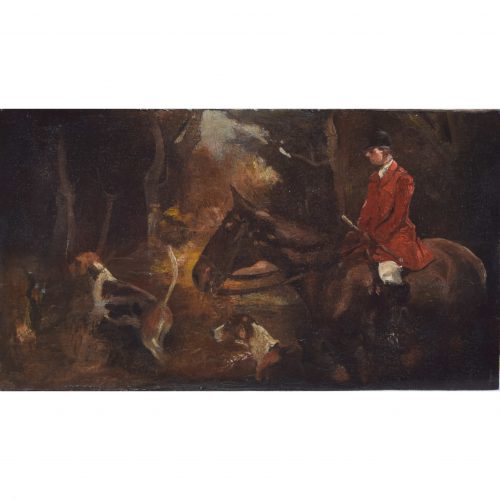
attr. John Ivester Lloyd (1873 - 1942)
Foxhunting
Oil on board 20 x 36 cm A huntsman and hounds pass through a dark wood. Thomas Ivester Lloyd (1873 - 1942) was born in Liverpool. During the First World War, he served with the Remount Service, in common with many other equine artists. He was later commissioned into the Royal Artillery. From childhood he hunted, and he became Master of the Sherington Foot Beagles. As well as his equine portraits, he illustrated some books. The pony books he illustrated were all written by his son, John Ivester-Lloyd. Condition: good; some craquelure. If you’d like to know more, please email info@manningfineart.co.uk or call us on 07929 749056. -
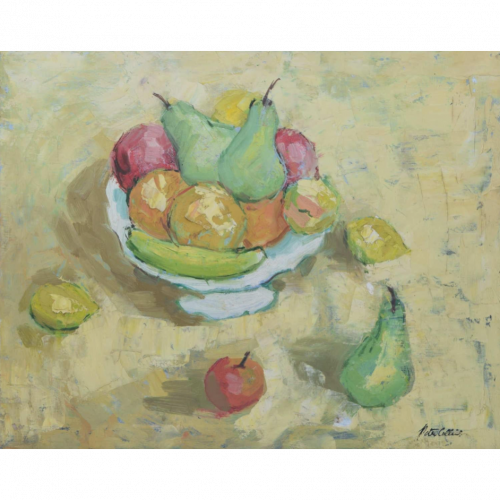
Peter Collins ARCA (1923-2001)
Still Life of a Fruit Bowl (c. 1960s)
Oil on canvas 40 x 51 cm Signed lower right. A stylish mid-century still life with fruit. Collins's first job was at an advertising agency, in the commercial studio. World War II interrupted his career and he joined the Royal Artillery (of the British Army), teaching painting and drawing in the Education Corps - whilst simultaneously teaching at St Martin's School of Art, part time. Following the war, Collins studied at the Royal College of Art, winning a scholarship. He then worked as a commercial artist, producing some well-known posters for clients including British Railways and British European Airways. He was the Art Director at Odhams Press and spent time designing for both ICI and Shell. With his wife Georgette, he created the 'Bacombe Galleries' in Sussex, converting a group of buildings into a gallery space. In 1975 they developed the Stanley Studios in Chelsea, which were scheduled for redevelopment, into a combined artists' studio and residence. Moving into the Stanley Studios allowed the Collinses to immerse themselves in Chelsea's art scene, and they proceeded to fill the studios with art, antiques, scupture, and other curios. Provenance: the artist's studio sale 2017, lot 2050. Condition: very good. -

Hanslip Fletcher (1874-1955) St John's College, Cambridge
20x30cm Pen and Wash If you are interested email info@manningfineart.co.uk or call us on 07929 749056. Condition: Good. -
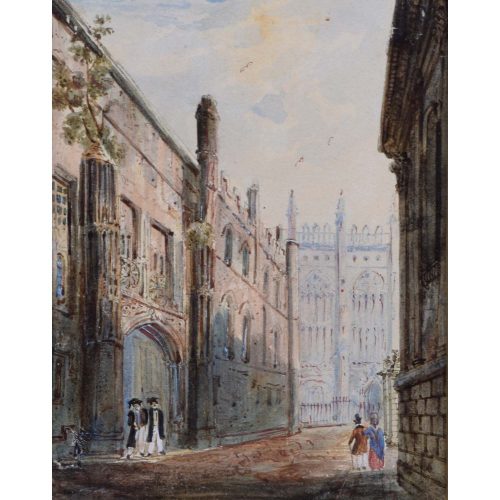
Anonymous King’s College Cambridge
Watercolour 11×9cm If you are interested email info@manningfineart.co.ukor call us on 07929 749056. Condition: Generally very good, small imperceptible hole in bottom left corner. -
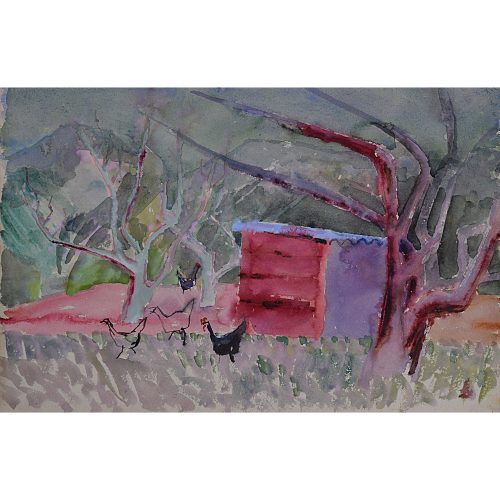
Clifford Ellis (1907-1985) Hens by a chicken shed at Corsham Court
Watercolour 37x56cm Provenance: the family of the artist, by descent. Here Ellis paints the hens at Corsham Court together with their chicken shed. Born in Bognor in Sussex and trained at St Martin’s School of Art and Regent Street Polytechnic, Ellis was a graphic artist and illustrator who is best known for the posters he produced for London Transport during the 1930s. He generally collaborated with his wife Rosemary – whom he married in 1931 – on their posters. The General Post Office, Shell, and The Empire Marketing Board were also clients for their posters. They signed their posters C&RE, their initials being in alphabetical order and they are readily recognisable by their ebullient use of colour and form. Employed during the war as a camoufleur, along with so many other artists, Clifford was also an official war artist, serving with the Grenadier Guards. Rosemary, meanwhile, was an artist for the Recording Britain project. Following the war they trained art teachers at Bath Academy of Art. They also designed a series of nearly one hundred book jackets for Collins New Naturalist series, published between 1945 and 1982. Clifford Ellis studied illustration at the Regent Street Polytechnic, an institution that specialised in ’practical trade classes’, from 1924-27. He went on to design book covers (notably for Collins’ ‘New Naturalist’ series) and posters for London Transport, the General Post Office, Shell-Mex, the Empire Marketing Board and J. Lyons & Co., along with his wife, Rosemary Ellis, whom he married in 1931 while he was teaching at the Polytechnic. The couple’s poster designs combine striking colour with bold typography and depict stylised scenes of the countryside, birds and animals. In the 1930s London Transport commissioned over forty posters a year from well-known artists such as Laura Knight, CRW Nevinson, Edward Wadsworth, Eric Ravilious, Paul Nash, Graham Sutherland and Edward McKnight Kauffer – a bold policy that did much to popularise avant-garde artistic styles that stemmed from Cubism, Futurism and Abstraction. Such an influence is clear in the Ellises poster ‘It’s better to shop early’ (above, 1935) in which arms, hands and parcels are disjointed and angular with the text on a slant, like the collaged newsprint insertions of synthetic Cubism. This strong foundation in graphic art clearly influenced his approach to composition for the rest of his career. Even his later abstract work, though tonally subtle, is based on a simple but powerful linear design. ‘The Coming of the Ice Age’, a series of watercolour and crayon studies (one large finished canvas, ‘Advance of an Ice Age’, exists in the collection of Derbyshire and Derby School Library Services) reduces natural forms to simplified shapes and colour planes, though retaining the texture of brushstrokes and crayon. The Ellises visited the Devon coastal town of Teignmouth to carry out a commission for Lyons for a lithograph in 1947, and the rocky bay with its whitewashed buildings and sailboats (below) caught Clifford’s imagination. He painted numerous preparatory watercolour views for the lithograph, while both the grey-blue colour palette as well as the pleasing repetitive geometry of sails reflected on water might be discerned in later abstract works. During the Second World War Ellis served as a camouflage artist and official war artist with the Grenadier Guards. Roland Penrose was another British artist who worked in this area and wrote ‘The Home Guard Manual of Camouflage’ which effectively adapted modern painting techniques for use in warfare. The tonal colour range of many of Ellis’s post-war paintings and the abstract network of shapes – for instance the pale blue patchwork ‘glacier’ in the ‘Coming of the Ice Age III’ (below) – seem to hark back to the art of the modernist camoufleur. Ellis played another important role during the war, painting and drawing scenes of Bath for the Recording Britain project. This project was conceived by Kenneth Clark, then Director of the National Gallery, alongside the official War Artists scheme; its aim was to document Britain’s landscape and architectural heritage in the face of the imminent threat of invasion and bomb damage. It also had a propaganda motive; the resulting works were exhibited during the war and aimed to boost the nation’s morale (they are now in the collection of the V&A). The paintings were predominantly in watercolour, a traditional British medium that Clark was keen to promote and felt would complement the subject matter. Two of Ellis’ pupils, discussing his watercolour sketch of VE Day in Bath, recall him as quietly observant but also someone who enjoyed life; the painting is spontaneous and full of the movement of dancing figures and waving flags. In particular, Ellis was commissioned to depict examples of Bath’s decorative architectural ironwork before it was removed to help the war effort and he also recorded the effects of bombing raids on the city. Meanwhile Ellis had joined the staff of the Bath School of Art (or Bath Technical College). Its temporary residence was destroyed by bombs in 1942 and Walter Sickert’s house at Bathampton offered as a refuge (Sickert, who had taught at the School, died in January 1942). After the war the School began its transformation into the Bath Academy of Art based at Corsham Court, of which Ellis was the Head from 1937-72, training art teachers and developing a pioneering new syllabus. If you are interested email info@manningfineart.co.uk or call us on 07929 749056. Condition: Excellent. In a conservation mount. -
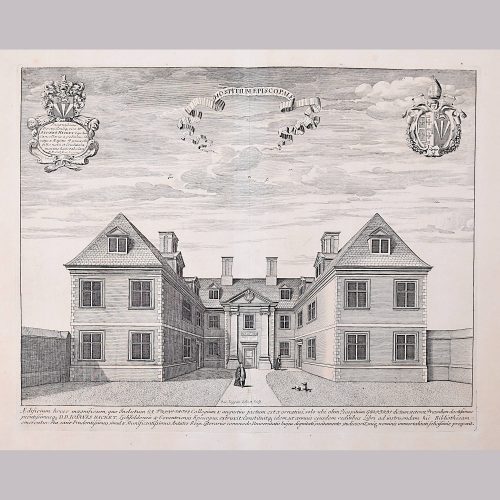
David Loggan (1634-1692) The Bishop's Hostal, Trinity College Cambridge
Engraving 1690 35x50cm Loggan was born to English and Scottish parents, and was baptised in Danzig in 1634. After studying engraving in Danzig with Willem Hondius (1598-1652 or 1658), he moved to London in the late 1650s, going on to produce the engraved title-page for the folio 1662 Book of Common Prayer. He married in 1663 and moved to Nuffield in Oxfordshire in 1665. Loggan was appointed Public Sculptor to the nearby University of Oxford in the late 1660s, having been commissioned to produce bird’s-eye views of all the Oxford colleges. He lived in Holywell Street as he did this. The 'Oxonia Illustrata' was published in 1675, with the help of Robert White (1645-1704). Following its completion, Loggan began work on his equivalent work for Cambridge; the 'Cantabrigia Illustrata' was finally published in 1690, when he was made engraver to Cambridge University. The 'Oxonia Illustrata' also includes an engraving of Winchester College (Winchester and New College share William of Wykeham as their founder) whilst the 'Cantabrigia Illustrata' includes one of Eton College (which shares its founder, Henry VIII, with King’s College). Bird’s-eye views from this era required a particular talent as an architectural perspectivist; it was not until 1783 that it became possible for artists to ascend via hot air balloons and view the scenes they were depicting from above. Loggan thus had to rely on his imagination in conceiving the views. Loggan’s views constitute the first accurate depictions of the two Universities, in many ways unchanged today. Whilst the Oxford engravings were produced in reasonable numbers and ran to a second edition by Henry Overton (on thicker paper and with a plate number in Roman numerals in the bottom right-hand corner), those of Cambridge were printed in much smaller numbers. The Dutchman Pieter van der Aa published some miniature versions of the engravings for James Beverell’s guidebook to the UK, 'Les Delices de la Grande Bretagne' (c. 1708). The contemporary artist Andrew Ingamells (b.1956) has produced a highly-acclaimed series of etchings which bring Loggan’s original vision up to date. If you are interested email info@manningfineart.co.uk or call us on 07929 749056. Condition: Some age toning as visible in photograph; usual handling wear and marks to edges, generally very good. -
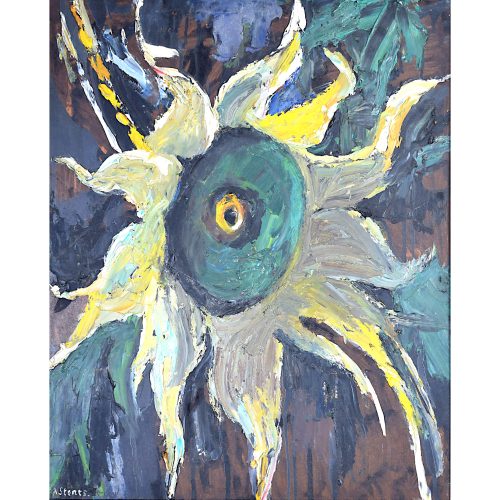
Angela Stones (1914-1995) Helianthus
Oil on canvasboard 44x55cm Signed lower left Stones was a member of an artistic dynasty. Her mother Dorothy Bradshaw (1893-1983) studied under Jack Merriott - the artist famous for his British Rail posters, and her son, Christopher Assheton-Stones (1947-1999) was probably the foremost pastel artist of his time. Here a generous use of impasto captures the texture of a Helianthus - Sunflower. A suggestion perhaps of surrealism in choice of colours helps with the mid-century feel of the painting. If you are interested email info@manningfineart.co.uk or call us on 07929 749056. Condition: Good. -
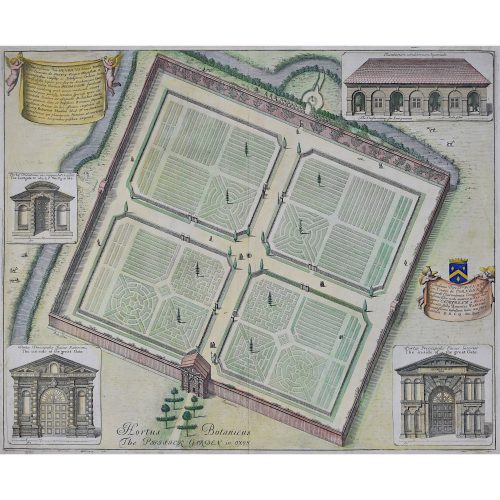
David Loggan (1634-1692) Botanic Gardens Oxford
Engraving (1675) with later hand colouring 30x40cm Loggan was born to English and Scottish parents, and was baptised in Danzig in 1634. After studying engraving in Danzig with Willem Hondius (1598-1652 or 1658), he moved to London in the late 1650s, going on to produce the engraved title-page for the folio 1662 Book of Common Prayer. He married in 1663 and moved to Nuffield in Oxfordshire in 1665. Loggan was appointed Public Sculptor to the nearby University of Oxford in the late 1660s, having been commissioned to produce bird’s-eye views of all the Oxford colleges. He lived in Holywell Street as he did this. The 'Oxonia Illustrata' was published in 1675, with the help of Robert White (1645-1704). Following its completion, Loggan began work on his equivalent work for Cambridge; the 'Cantabrigia Illustrata' was finally published in 1690, when he was made engraver to Cambridge University. The 'Oxonia Illustrata' also includes an engraving of Winchester College (Winchester and New College share William of Wykeham as their founder) whilst the 'Cantabrigia Illustrata' includes one of Eton College (which shares its founder, Henry VIII, with King’s College). Bird’s-eye views from this era required a particular talent as an architectural perspectivist; it was not until 1783 that it became possible for artists to ascend via hot air balloons and view the scenes they were depicting from above. Loggan thus had to rely on his imagination in conceiving the views. Loggan’s views constitute the first accurate depictions of the two Universities, in many ways unchanged today. Whilst the Oxford engravings were produced in reasonable numbers and ran to a second edition by Henry Overton (on thicker paper and with a plate number in Roman numerals in the bottom right-hand corner), those of Cambridge were printed in much smaller numbers. The Dutchman Pieter van der Aa published some miniature versions of the engravings for James Beverell’s guidebook to the UK, 'Les Delices de la Grande Bretagne' (c. 1708). The contemporary artist Andrew Ingamells (b.1956) has produced a highly-acclaimed series of etchings which bring Loggan’s original vision up to date. If you’d like to know more, please email info@manningfineart.co.uk or call us on 07929 749056. -
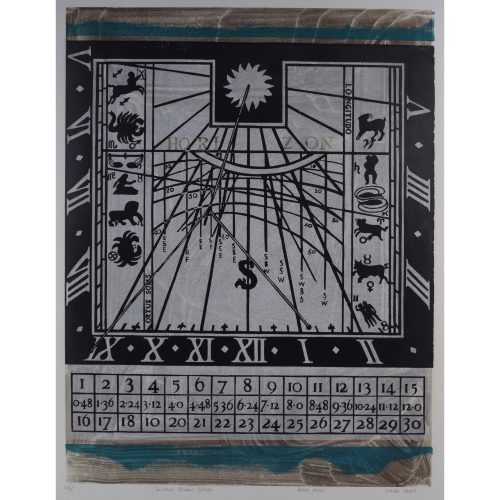
Walter Hoyle
Queens' College Cambridge, Sundial
Linocut, 1965 76x57 cm Signed numbered and titled in pencil. Printed on handmade Japanese Hosho paper by the artist at Editions Electo Click here for biographical details and other works by the artist. If you are interested email info@manningfineart.co.uk or call us on 07929 749056. -
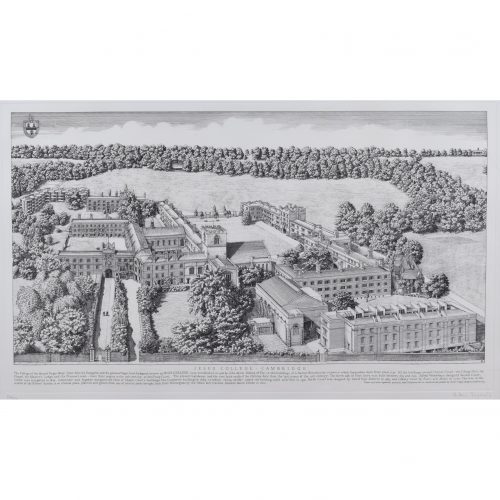
Andrew Ingamells Jesus College, Cambridge
Etching and aquatint 58 x 84 cm Signed in pencil and numbered from the edition of 150. Inspired by David Loggan’s celebrated engraving of the College in 1680, this view of Jesus College was the first of Ingamells’ series of views of Oxford and Cambridge. It took six months to complete and has long-since sold out from the publisher. The Master and Fellows of the College own both the original drawing, which the engraving is based upon, and the copper etching plate used to make the prints. Ingamells trained at St Albans School of Art and the London College of Printing, subsequently working as a graphic designer and illustrator. Based in London, he began making drawings of the buildings and landscapes of London. Ingamells' work is in many public collections including those of the Tate Gallery, The National Trust, The Paul Mellon Centre for British Art, and the City of London Guildhall Library. His pictures are also in several private collections, including those of various Oxford and Cambridge colleges, HRH King Charles III, and Shell Oil. The artist is currently part-way through his epic project to record all the colleges of Oxford and Cambridge, a project undertaken in homage to David Loggan. -
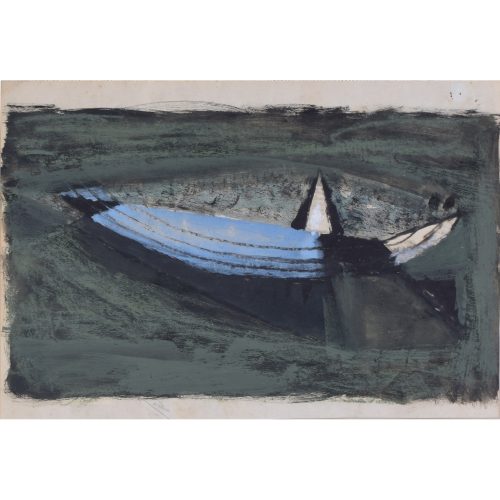
Clifford Ellis (1907-1985)
Coming of the Ice Age I
Watercolour 16x25cm For the artist's biographical details and to see the other three designs from this series available for sale please click here. If you are interested email info@manningfineart.co.uk or call us on 07929 749056. -
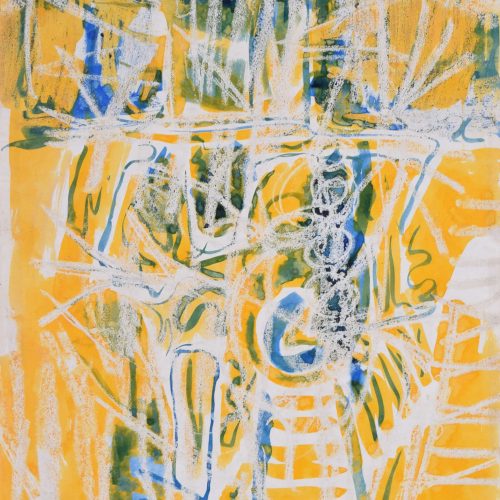
Charles Pulsford ARSA (1912 - 1989)
Abstract Figure in Yellow and Blue
Watercolour and ink 56 x 38 cm Signed lower right. An abstract figure in arresting colours. The artist plays with the intersection of round and lateral mark-making to form a human figure, perhaps reminiscent of a crucifixion. Pulsford's skill as an abstract landscape artist is also evident here, with the form suggestive of natural and industrial topography like fields, rivers, railway tracks, and electric pylons. Pulsford was born in Staffordshire to Scottish parents. His family returned to Dunfermline when he was a child, and he subsequently attended Edinburgh College of Art (ECA) between 1933 and 1937. He, along with other prominent Scottish artists, embraced modernism and abstraction following the end of the war. Alan Davie, William Turnbull, William Gear and Eduardo Paolozzi are the key artists of the group with which he was association, and the National Galleries of Scotland regard Pulsford as the 'fifth man' of the group. Between 1952 and 1960 he taught at ECA and then at Canterbury College of Art. Condition: generally very good, old tape stains to extreme margins. If you are interested email info@manningfineart.co.uk or call us on 07929 749056. Provenance: the artist, the residual stock of William Hardie. -
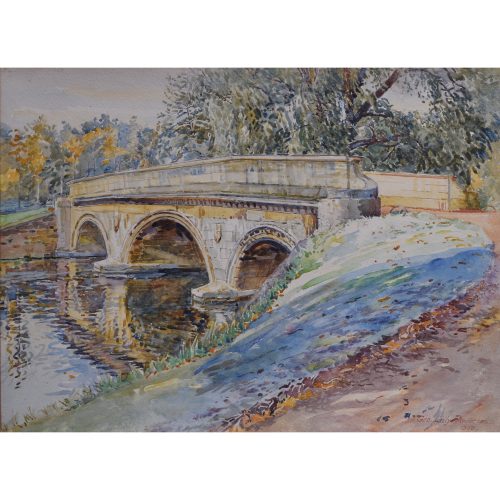
George Lilly Anderson (British b. 1870)
Trinity College Cambridge Bridge
28x38cm Watercolour Intriguingly nothing is known of Anderson's life, apart from the carefully painted landscapes. If you are interested email info@manningfineart.co.uk or call us on 07929 749056. -
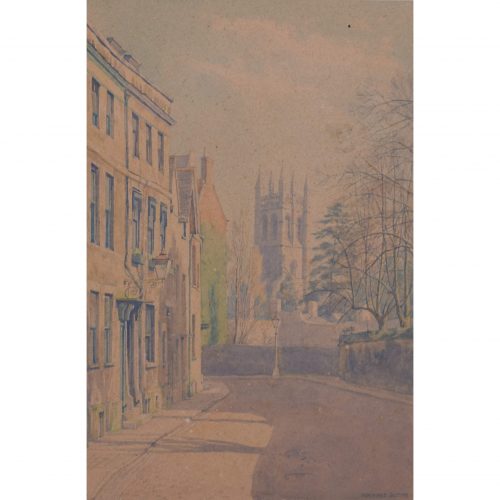
Bernard Cecil Gotch (1876 - 1964)
Merton Street, Oxford
Watercolour 37 x 25.5 cm Signed in pencil lower right. A wintry view of Holywell Street, Oxford, where Charles Ryder and Sebastian Flyte famously take up lodgings in Brideshead Revisited. Magdalen Tower peeps out over the cobbled lane. On the other side of the wall is the Fellows Garden of Merton College. Bernard Cecil Gotch was a Winchester-born artist who is best known for his atmospheric watercolours of Britain's towns and cities (most notably Oxford). He moved to Oxford in 1927, painting many watercolours of the interiors and exteriors of Oxford’s many buildings. His works concentrate on the grand exteriors and interiors of the University's colleges, and he exhibited frequently - including an exhibition every term at Oriel College. His first notable commission was for the publisher Methuen, illustrating ''A Shepherd’s Life'' by W H Hudson. Whilst in London he was invited to illustrate a book on the Public Schools of England (which was sadly never completed). He exhibited watercolours at the Fine Art Society and Lincolns Inn, and also exhibited at the Royal Academy. In 1952 Gotch was given an Honorary MA by the University of Oxford, and, after his death in 1963, a memorial was held for him at Oriel. Condition: slight discolouration to paper. If you’d like to know more, please email info@manningfineart.co.uk or call us on 07929 749056. -
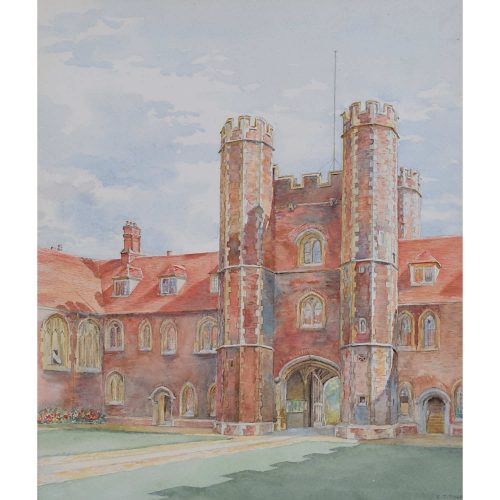
E. T. Talbot
St John's College, Cambridge, showing the First Court and Chapel
Watercolour 30 x 25 cm A richly-coloured watercolour painting of the First Court of St John's. First Court was built in 1511-20 to the south of the old Hospital of St John the Evangelist, and was designed to contain living quarters, chapel, library, hall, and kitchens. The version of First Court which Talbot paints looks markedly different to the college today - the chapel on the far left of the picture was demolished after the new chapel was completed in 1869. -
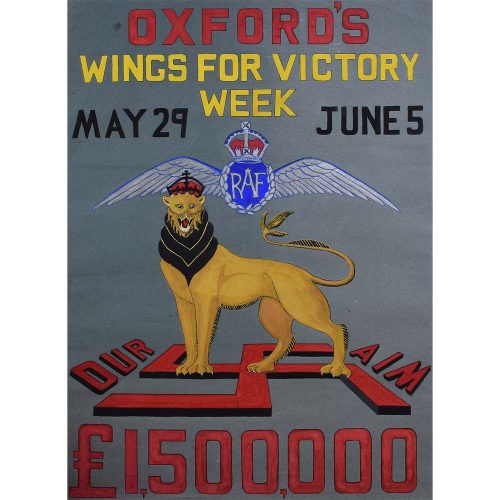
Anonymous
Oxford Wings for Victory Poster Design IV
c.1943 Gouache on paper 70 x 51 cm 89 x 68 cm including hand-finished frame, UK shipping only Click here to see other posters from this series. If you are interested email info@manningfineart.co.uk or call us on 07929 749056. Condition: Excellent. -
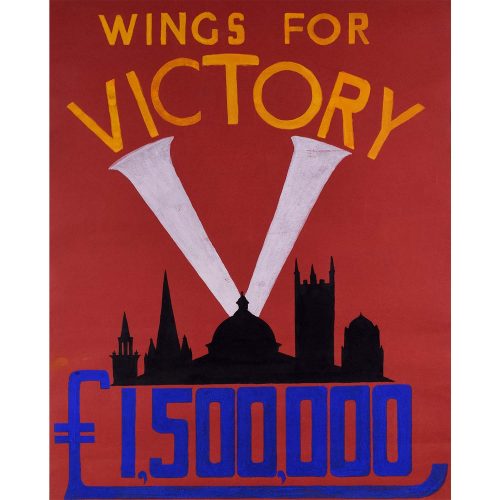
Anonymous
Oxford Wings for Victory Poster Design II
c.1943 Gouache on paper 63 x 50 cm 81x66cm including hand-finished frame, UK shipping only Click here to see other posters from this series. If you are interested email info@manningfineart.co.uk or call us on 07929 749056. Condition: Excellent. -
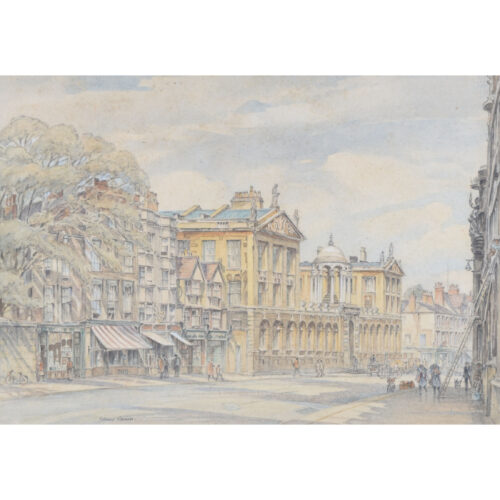
William Sydney Causer (1876 - 1958)
Queen's College, Oxford
Watercolour 38 x 53 cm A most agreeable depiction of Queen's College on the High. The college's Headington Stone is made golden by the sun. William Sidney Causer was a landscape artist known coastal and his urban scenes. He studied at the Wolverhampton School of Art and exhibited at the Royal Academy for the first time in 1923, and later the Paris Salon. Causer painted several pictures in Spain before the Civil War there, and also painted landscapes in France and Italy as well as the English South Coast. Condition: generally very good. If you are interested, please email info@manningfineart.co.uk or call us on 07929 749056. Click here for other views of Queen's College, Oxford. -

Angela Stones (1914 - 1995)
Still Life with Fruit and Bottle
Oil on board 39 x 49 cm A stylish mid-century still life. Stones was educated at the Chelsea School of Art, and was a member of an artistic dynasty. Her mother Dorothy Bradshaw (1893-1983) studied under Jack Merriott – the artist famous for his British Rail posters, and her son, Christopher Assheton-Stones (1947-1999), was arguably the foremost pastel artist of his time. Provenance: the family of the artist. Condition: Generally very good. If you’d like to know more, please email info@manningfineart.co.uk or call us on 07929 749056. -
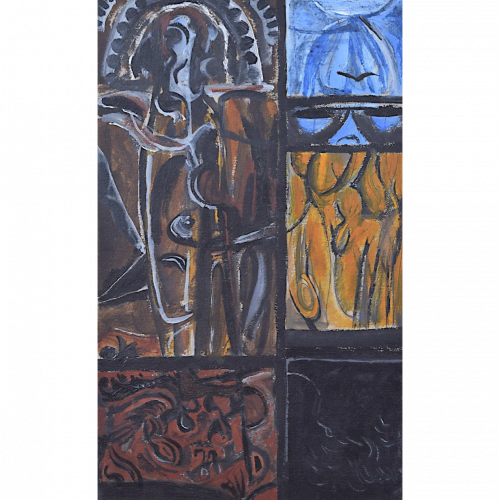
Charles Pulsford ARSA (1912-1989)
Abstract Stained Glass Design
Gouache 40 x 25 cm Provenance: the artist, the residual stock of William Hardie Gallery. This mesmerising depiction of an abstract figure is likely a design for a stained glass window panel. Pulsford was born in Staffordshire to Scottish parents. His family returned to Dunfermline when he was a child, and he subsequently attended Edinburgh College of Art (ECA) between 1933 and 1937. He, along with other prominent Scottish artists, embraced modernism and abstraction following the end of the war. Alan Davie, William Turnbull, William Gear and Eduardo Paolozzi are the key artists of the group with which he was association, and the National Galleries of Scotland regard Pulsford as the 'fifth man' of the group. Between 1952 and 1960 he taught at ECA and then at Canterbury College of Art. Condition: Generally very good. If you are interested, email info@manningfineart.co.uk or call us on 07929 749056. -
Out of stock
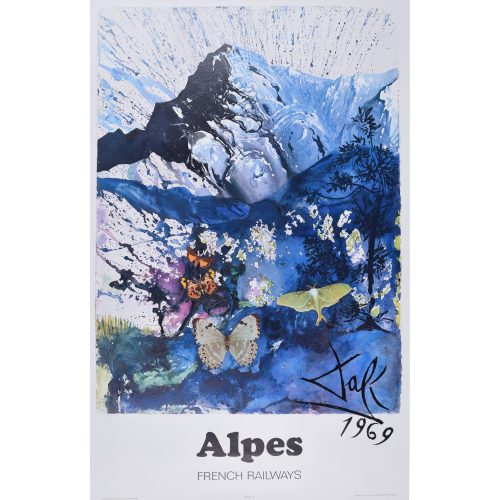
Salvador Dali (1904-1989) Alpes French Railways - The Alps
Original Poster for French Railways SNCF 40x25" (100x67cm) Printed by Draeger Printed in France for and by the French National Railways, 1970 Signed and dated in the stone 1969 Printed on wove - a thicker paper than the standard poster which is also textured. Condition: very good -
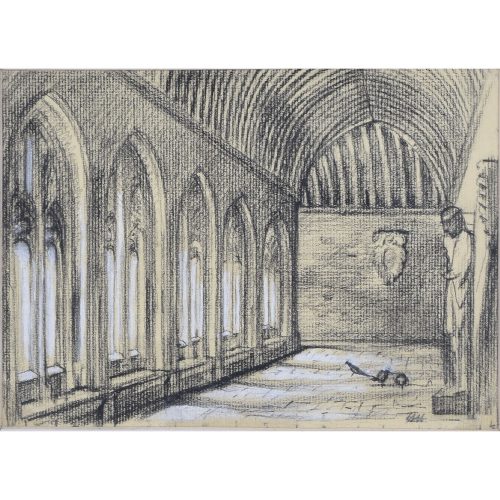
Hubert Hennes (b. 1907)
New College, Oxford (sketch)
Crayon and watercolour Signed 14x21cm If you are interested email info@manningfineart.co.uk or call us on 07929 749056. -
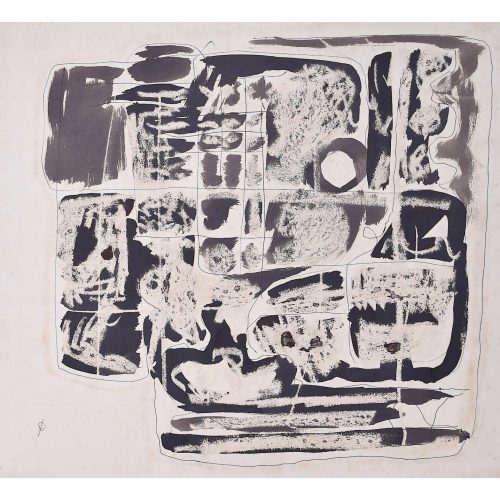
Charles Pulsford ARSA (1912-1989)
'Monochrome Landscape'
Watercolour with ink 39 x 43 cm Initialled lower left Provenance: the artist; the residual stock of William Hardie. Pulsford was born in Staffordshire to Scottish parents. His family returned to Dunfermline when he was a child, and he subsequently attended Edinburgh College of Art (ECA) between 1933 and 1937. He, along with other prominent Scottish artists, embraced modernism and abstraction following the end of the war. Alan Davie, William Turnbull, William Gear and Eduardo Paolozzi are the key artists of the group with which he was association, and the National Galleries of Scotland regard Pulsford as the 'fifth man' of the group. Between 1952 and 1960 he taught at ECA and then at Canterbury College of Art. Condition: Good. Paper slightly toned, a little spotting. If you are interested, please email info@manningfineart.co.uk or call us on 07929 749056. -
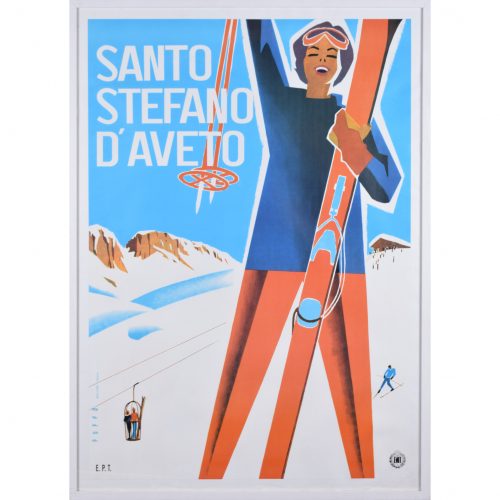
Mario Puppo (1905 - 1977)
Santo Stefano d'Aveto
Original vintage poster 97 x 68 cm Produced circa 1955 for Italian Railways. Mario Puppo's poster advertising the Italian ski resort of Santo Stefano d'Aveto. The figure of a skier reaches upward in triumph; behind her, a vintage ski lift makes its way up the mountain and a blue-clad skier tackles the piste. Mario Puppo was born in Levanto, Italy, and worked in a studio in Chiavari. He designed leaflets advertising skiing and beach resorts, which gained popularity in the 1930s. By the 1940s his poster designs were being featured in the Milan Advertising Graphics show. Throughout the 1940s he designed covers for catalogues, leaflets, playbills, music scores and records, as well as producing more travel posters for public and private Italian companies. Condition: backed to linen; frame included for UK mainland only (excluding Cornwall, Highlands and Islands - where further shipping charges may apply). If you are interested, please email info@manningfineart.co.uk or call us on 07929 749056. Click here for more original vintage posters. -
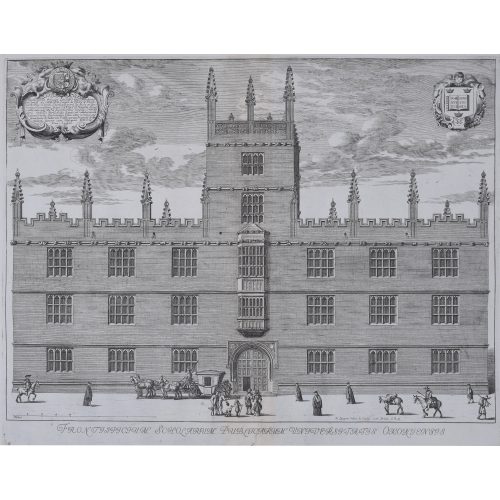
David Loggan (1634-1692)
Frontispiece Public Schools Oxford
Engraving 33x42cm If you are interested email info@manningfineart.co.uk or call us on 07929 749056. -
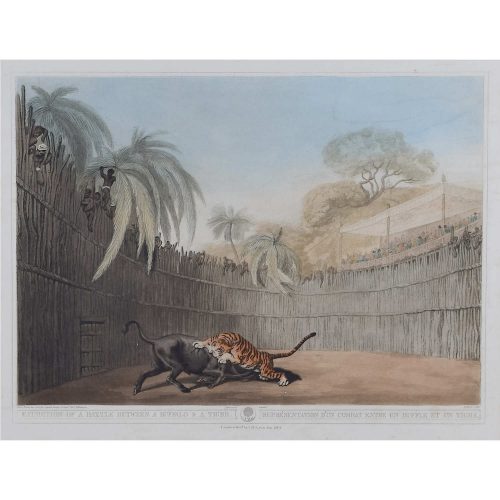
Samuel Howitt (1765-1822) after Thomas Williamson (1758-1817)
Exhibition of a Battle between a Buffalo & a Tiger' from Oriental Field Sports (1819)
Hand-coloured aquatint 35 x 47 cm Captain Thomas Williamson served in a British regiment in Bengal, India. He was known as a keen sportsman and, after returning to England, his notable interest in contemporary Indian sports attracted the attention of the publisher Edward Orme. Orme was a British engraver, painter and publisher of illustrated books, and in 1805 he commissioned Williamson to produce a work focused on Oriental sports and animals. The book took two years to complete, with the painter Samuel Howitt commissioned to produce watercolours based on original sketches by Williamson, most of which he had created while in India. The book in which the aquatint plates after Howitt were published was called Oriental Field Sports, which describes itself as 'being a complete, detailed, and accurate description of the wild sports of the East and exhibiting, in a novel and interesting manner, the natural history of the elephant, the rhinoceros, the tiger, and other undomesticated animals'. -
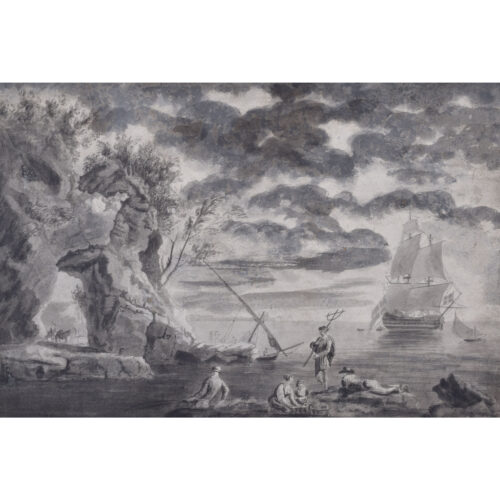
John Cantiloe Joy (1805 - 1859) / William Joy (1803 - 1865) (attributed)
Trident on the Shore
Pencil and wash 28 x 42 cm A 19th century engraving of a ship near a shore. Various figures, including one wielding a trident, appear in the foreground. John Cantiloe Joy and William Joy were brothers who worked together as English marine artists. During the 1820s, the brothers' paintings were exhibited at the Norwich Society of Artists, the Royal Society of British Artists, the Royal Academy and at the British Institution. They belonged to the Norwich School of painters which specialised in maritime scenes and views of rural Norfolk and Norwich. Condition: generally very good; mounted to board. If you are interested, please email info@manningfineart.co.uk or call us on 07929 749056. -
Out of stock
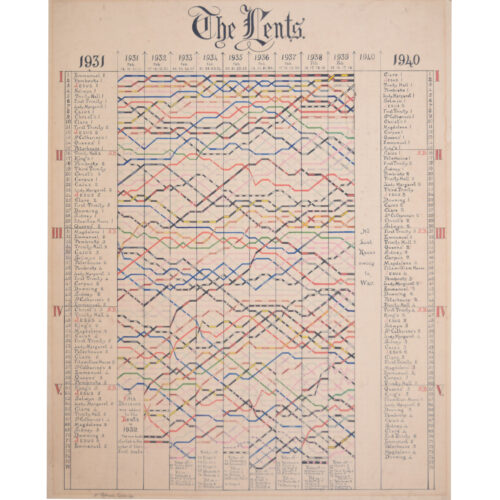
V Robinson
The Lent Bumps 1931 - 1940
Pen, ink and watercolour 60 x 48 cm A hand-painted chart illustrating the results of the Lent Bumps from 1931 to 1939, with a note that in 1940 there were 'No Lent Races due to War'. The Lent Bumps, also known as "Lents" or the Lent Races are a set of University of Cambridge rowing races held each year on the River Cam. The races are open to all college boat clubs from the University of Cambridge, the University Medical and Veterinary Schools and Anglia Ruskin Boat Club. The Lent Bumps take place over five days (Tuesday to Saturday) at the end of February / start of March and are run as bumps races (of rowing race in which a number of boats chase each other in single file, each crew attempting to catch and 'bump' the boat in front without being caught by the boat behind). The men's races officially began in 1887 and the women's in 1976. Condition: generally good; some age toning to board and a little staining to the margins that will be hidden by a mount. If you are interested, please email info@manningfineart.co.uk or call us on 07929 749056. Click here for other Cambridge pictures. -
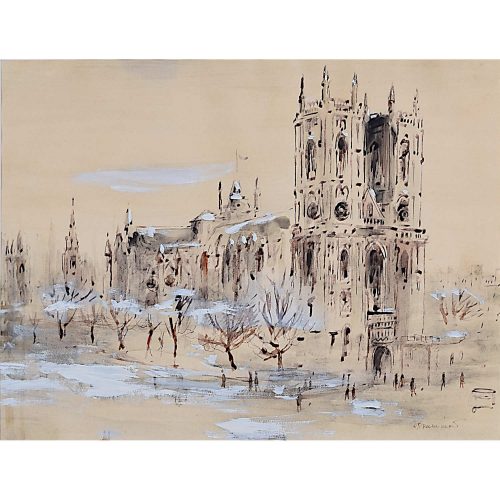
Violet Hilda Drummond (British, 1911-2000)
Westminster Abbey
Watercolour 33 x 43 cm Signed lower right. Here, the artist paints a sprightly view of Westminster Abbey, which rises from a sea of nondescript pedestrians. The mostly monochrome palette, gently highlighted with splashes of a muted red, and white details, communicates the character of the city. Drummond's father, a Scots Guard, was killed at Ypres in 1914. Drummond and her two sisters were brought up by her mother and educated in Eastbourne and at Le Chateau Vitry-sur-Seine, a Parisian finishing school. After Paris, Drummond attended St Martin’s School of Art. Later in life, she began writing children’s picture books – the most notable being Miss Anna Truly (1945) and her Little Laura series (1960 onwards). She also produced cartoons for the BBC. 'Mrs Easter and the Stork' – published in 1957 by Faber & Faber – was awarded the Kate Greenway Medal. Drummond later took to painting watercolours of London street scenes which have remained popular ever since. Provenance: the Arthur Andersen art collection. -
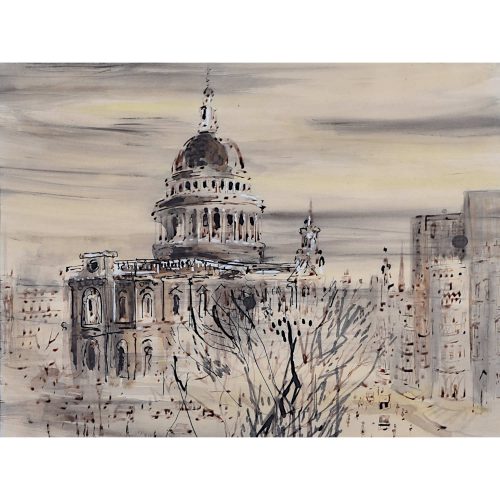
Violet Hilda Drummond (British, 1911-2000)
St Paul's Cathedral
Watercolour 33 x 43 cm Signed upper right (visible in the photograph showing the framed painting). Provenance: the Arthur Andersen art collection. Here, the artist paints a sprightly view of St Paul's, which rises from a sea of nondescript traffic and pedestrians. The mostly monochrome palette, gently highlighted with a yellow wash and white details, communicates the character of the city. Drummond's father, a Scots Guard, was killed at Ypres in 1914. Drummond and her two sisters were brought up by her mother and educated in Eastbourne and at Le Chateau Vitry-sur-Seine, a Parisian finishing school. After Paris, Drummond attended St Martin’s School of Art. Later in life, she began writing children’s picture books – the most notable being Miss Anna Truly (1945) and her Little Laura series (1960 onwards). She also produced cartoons for the BBC. 'Mrs Easter and the Stork' – published in 1957 by Faber & Faber – was awarded the Kate Greenway Medal. Drummond later took to painting watercolours of London street scenes which have remained popular ever since. -
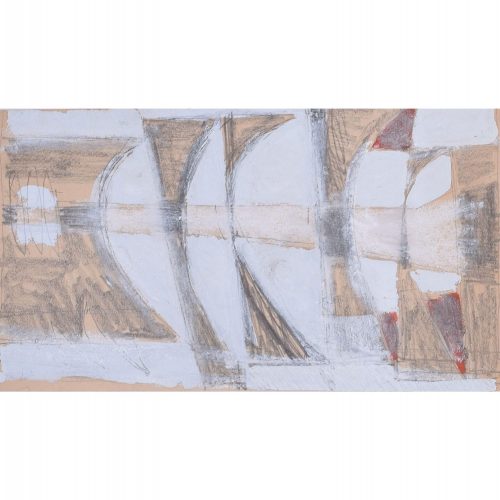
Clifford Ellis (1907-1985)
Sailing Boats in White
Pencil and gouache 26x14cm Provenance: the family of the artist, by descent. Click here for biographical details and other works by the artist. If you are interested email info@manningfineart.co.uk or call us on 07929 749056. -
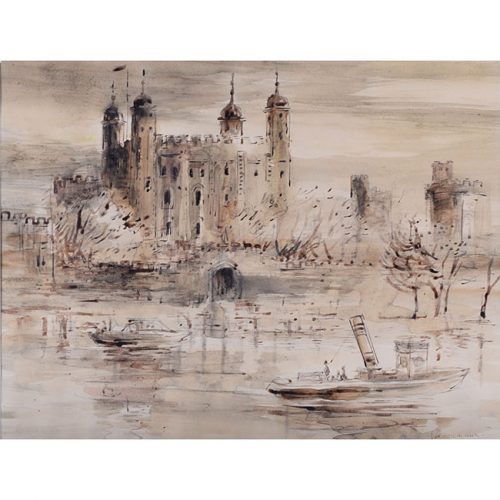
Violet Hilda Drummond
The Tower of London
Watercolour 33 x 42 cm An evocative view of the Thames and The Tower in Drummond's distinctive style. Provenance: The Arthur Andersen Collection, The Deloitte Collection. Click here for other works by the artist and biographical details. If you are interested email info@manningfineart.co.uk or call us on 07929 749056. -

M Gerling
St John's College, Cambridge
Pen and ink 15 x 26 cm Titled, dated June 1885, and signed lower right, all in ink. Condition: generally very good; painted on card; slightly toned. If you are interested, please email info@manningfineart.co.uk or call us on 07929 749056. Click here for other views of St John’s College, Cambridge. -
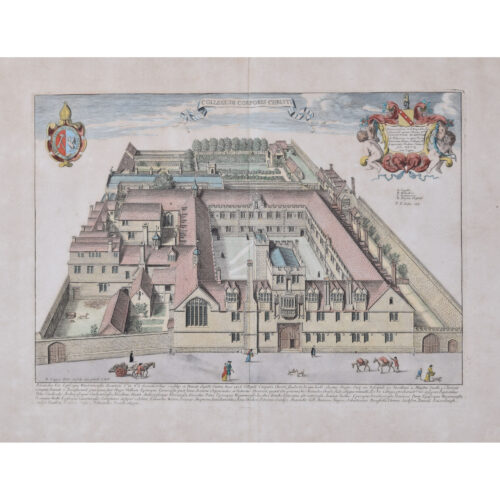
David Loggan (1634 - 1692)
Corpus Christi College, Oxford (1675)
Engraving 30 x 41 cm Loggan's view of Corpus from the 'Oxonia Illustrata', with later hand colouring. Loggan was born to English and Scottish parents, and was baptised in Danzig in 1634. After studying engraving in Danzig with Willem Hondius (1598-1652 or 1658), he moved to London in the late 1650s, going on to produce the engraved title-page for the folio 1662 Book of Common Prayer. He married in 1663 and moved to Nuffield in Oxfordshire in 1665. Loggan was appointed Public Sculptor to the nearby University of Oxford in the late 1660s, having been commissioned to produce bird’s-eye views of all the Oxford colleges. He lived in Holywell Street as he did this. The 'Oxonia Illustrata' was published in 1675, with the help of Robert White (1645-1704). Following its completion, Loggan began work on his equivalent work for Cambridge; the 'Cantabrigia Illustrata' was finally published in 1690, when he was made engraver to Cambridge University. The 'Oxonia Illustrata' also includes an engraving of Winchester College (Winchester and New College share William of Wykeham as their founder) whilst the 'Cantabrigia Illustrata' includes one of Eton College (which shares its founder, Henry VIII, with King’s College). Bird’s-eye views from this era required a particular talent as an architectural perspectivist; it was not until 1783 that it became possible for artists to ascend via hot air balloons and view the scenes they were depicting from above. Loggan thus had to rely on his imagination in conceiving the views. Loggan’s views constitute the first accurate depictions of the two Universities, in many ways unchanged today. Whilst the Oxford engravings were produced in reasonable numbers and ran to a second edition by Henry Overton (on thicker paper and with a plate number in Roman numerals in the bottom right-hand corner), those of Cambridge were printed in much smaller numbers. The Dutchman Pieter van der Aa published some miniature versions of the engravings for James Beverell’s guidebook to the UK, 'Les Delices de la Grande Bretagne' (circa 1708). The contemporary artist Andrew Ingamells (born 1956) has produced a highly-acclaimed series of etchings which bring Loggan’s original vision up to date. Condition: generally very good; a little discolouration to paper. Later hand colouring. If you are interested, please email info@manningfineart.co.uk or call us on 07929 749056. Click here for other views of Corpus Christi College, Cambridge. -
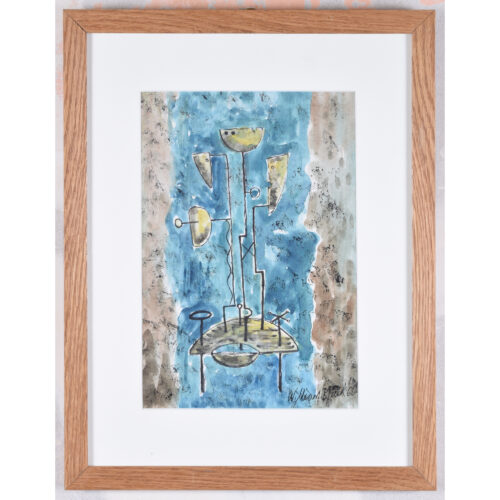
William Black Design for Sculpture (1966)
Watercolour 18 x 16 cm Signed and dated lower right. A design for a metal sculpture, on a blue- and grey-toned background. William Black was a St Ives artist who began his career as an architect. In the 1950s he came into money and ran away to St Ives to become a professional artist, studying under John Tunnard and associating with other artists like Ben Nicholson and Barbara Hepworth. Black rarely put up work for sale during his lifetime and is known for his architectural and deconstructivist sculptures which espoused the modernist spirit of the St Ives group in the 1960s. Condition: generally very good. If you are interested, please email info@manningfineart.co.uk or call us on 07929 749056. Click here for other Modern British Art. -
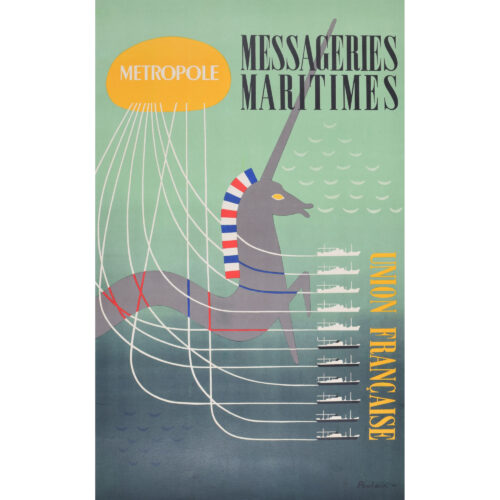
Poulain
Messageries Maritimes - Union Française
Original vintage poster 98 x 63 cm Poulain's poster advertising the Messageries Maritimes (a French merchant shipping company) features a unicorn with a mane in the colours of the French flag. Condition: generally very good; backed to linen; evidence of a few short old edge tears now largely invisible. If you are interested, please email info@manningfineart.co.uk or call us on 07929 749056. Click here for other original vintage posters. -
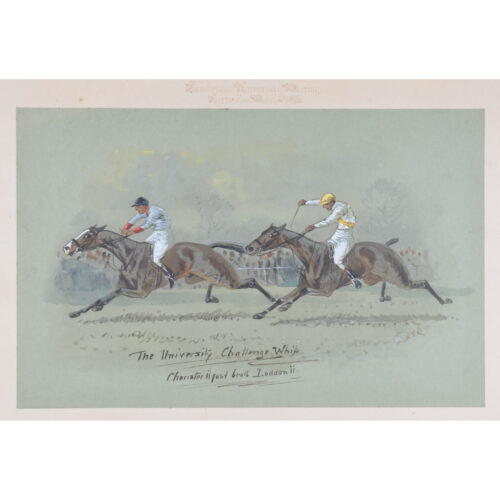
William Verner Longe (1857-1924)
The University Challenge Whip (1900)
Watercolour 29 x 45 cm Signed and inscribed "Choristor ii just beats Loddon ii". Inscribed 'Cambridge University Meeting, Cottenham, March 1909' to mount. A lively racing scene by William Verner Longe, and English artist noted for his scenes of racing, hunting, and other equestrian activities. He was educated at the Ipswich School of Arts and then the Royal Academy of Fine Arts in Antwerp. Condition: generally good; some spots to mount. If you are interested, please email info@manningfineart.co.uk or call us on 07929 749056. Click here for other Cambridge pictures. -
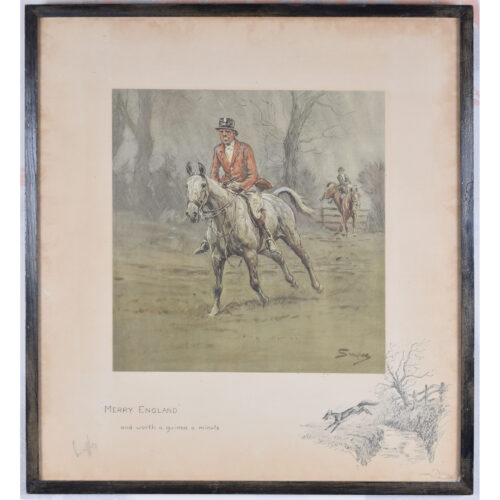
Charles "Snaffles" Johnson Payne (1884 - 1967)
"Merry England and worth a guinea a minute"
Lithograph 44 x 41 cm Signed in pencil lower left. Snaffles was one of the foremost sporting artists of his era, publishing many popular prints such as these: hunting pictures, racing scenes, and military subjects. Snaffles' distinctive drawing style is emphasised by his 'remarque' - sketches in the margin - and his witty titles. Condition: generally good; some age toning to backing paper. In original half-inch black frame. If you are interested, please email info@manningfineart.co.uk or call us on 07929 749056. Click here for other hunting pictures. -
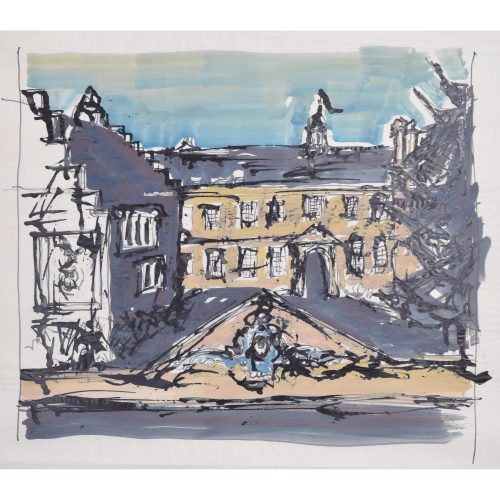
Margaret Souttar (1914 - 1987)
Trinity Hall, Cambridge II
Acrylic paint 56 x 65 cm cm Souttar was a Scottish painter and printmaker known for her town- and cityscapes. In the early 1960s, she was commissioned to produce a series of prints of the Cambridge colleges. She captures the modernity and optimism of 1960s Cambridge; the fact that a female artist was commissioned to create the prints reflects the changing attitudes of the University towards women. Trinity Hall was one of the first Cambridge colleges to admit women as students – it did not do so until 1976.6. Provenance: the artist's studio sale. Condition: generally very good, some crinkling as a result of using water-based paints on thin paper. If you are interested, please email info@manningfineart.co.uk or call us on 07929 749056. Click here for other views of Trinity Hall. -

Lady Margaret Myddleton (1910 - 2003)
Harbour at Menton
Oil on canvas 32 x 45 cm Signed lower left, and titled on label to reverse. Myddleton's sunny view of this fashionable Cote d'Azur port sees two sailing boats make their way into the harbour, as three onlookers watch from the pier. Behind them rise the town's sun-drenched buildings, including the basilica of Saint-Michel-Archange, and the purple of the French Alps. Lady Margaret Myddleton was an accomplished painter, painting interiors, country houses, and landscapes (both home and abroad). This was likely painted while Lady Myddleton was holidaying on the French Riviera. Most of her watercolours are on display in Chirk Castle, Wrexham, the family seat of the Myddleton family since 1593 (although the castle's ownership was transferred to the National Trust in 1981). Lady Myddelton was the chatelaine of the castle for thirty years, and died there in 2003. She had married Lt-Col Ririd Myddelton (Deputy Master of the Household to King George VI) in 1931, and the couple struggled to maintain the castle and estate. In 1978, Chirk and its 468 acres of parkland were bought for the nation through the National Land Fund and for the next three years were administered by the Welsh Office. In 1981 they passed to the National Trust, which now manages them. Condition: very good. If you are interested, please email info@manningfineart.co.uk or call us on 07929 749056. Click here for more Modern British original painting. -
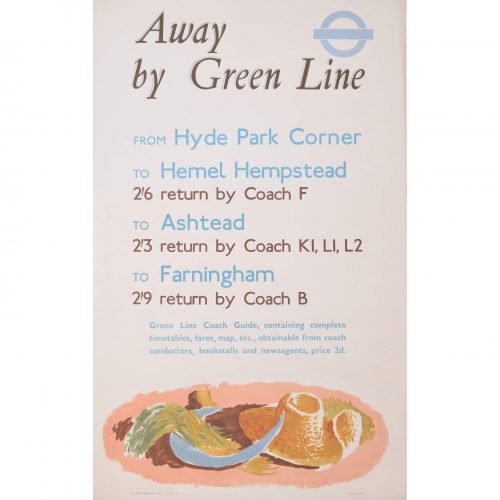
Graham Sutherland (1903 - 1980)
Away by Green Line (1936)
Original vintage poster 103 x 63 cm A poster produced for London Transport illustrating the pleasurable destinations to be reached via Green Line Coaches. Sutherland's design depicts a scythe, a sheaf of wheat, and a farmer's sunhat - three promises of country life which the city-dweller might now easily access, thanks to the advent of British coach travel. Graham Sutherland OM was an English artist known for his romantic, abstract landscapes and portraits of public figures, including Churchill and the Queen Mother. Sutherland spent the 1920s mostly making landscape prints, but, following the collapse of the print market in the early 1930s branched out into watercolours. He also undertook a few commercial commissions for posters, working for London Transport, Shell and others. He served as an official war artist in the Second World War, painting industrial scenes on the British home front. After the war he worked in oils and explored figurative painting. Condition: generally very good. If you are interested, please email info@manningfineart.co.uk or call us on 07929 749056. Click here for other London Transport posters. -
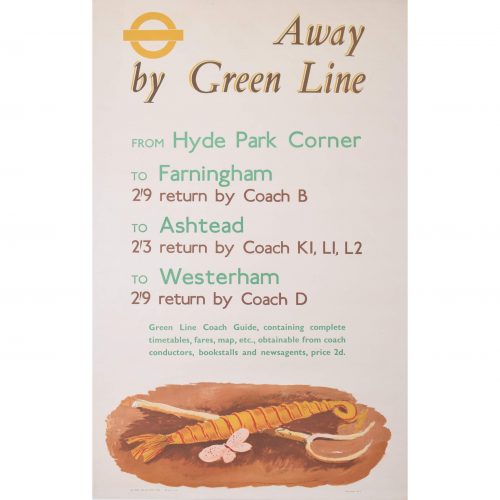
Graham Sutherland (1903 - 1980)
Away by Green Line (1936)
Original vintage poster 103 x 63 cm A copy of this poster is held by the London Transport Museum (1983/4/4500). A poster produced for London Transport illustrating the pleasurable destinations to be reached via Green Line Coaches. Sutherland's design depicts a pitchfork and a maize dolly - two promises of country life which the city-dweller might now easily access, thanks to the advent of British coach travel. Graham Sutherland OM was an English artist known for his romantic, abstract landscapes and portraits of public figures, including Churchill and the Queen Mother. Sutherland spent the 1920s mostly making landscape prints, but, following the collapse of the print market in the early 1930s branched out into watercolours. He also undertook a few commercial commissions for posters, working for London Transport, Shell and others. He served as an official war artist in the Second World War, painting industrial scenes on the British home front. After the war he worked in oils and explored figurative painting. Condition: generally very good, one repaired short tear about 10mm long. If you are interested, please email info@manningfineart.co.uk or call us on 07929 749056. Click here for other London Transport posters. -
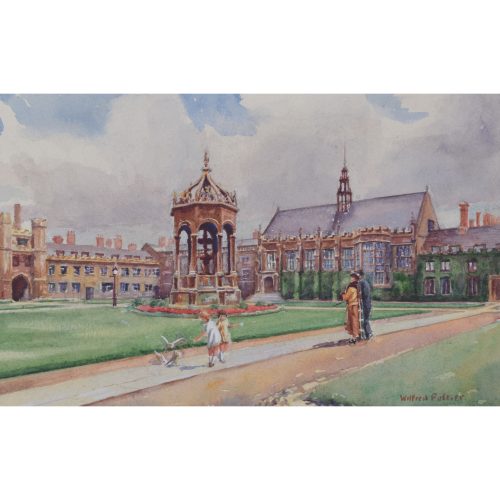
Wilfred Pettitt (1904 - 1978)
Great Court, Trinity College, Cambridge
Watercolour 17 x 27 cm A smartly-dressed couple and their two children enjoy the sunny and immaculately-lawned Great Court of Trinity College, Cambridge. The man and woman admire the ornate fountain which stands sentinel in the middle of the court (it, along with the rest of Great Court, was erected by by Thomas Nevile, master of the college in the early 17th century). Their children, perhaps oblivious to the architectural majesty around them, amuse themselves by playing with the pigeons. Wilfred Stanley Pettitt was born in Great Yarmouth, and studied at the Great Yarmouth School of Art and the Norwich School of Art. In 1928 he showed at the Royal Academy Royal Academy for the first time, and his work was also exhibited by the Royal Society of British Artists and the Royal Cambrian Academy. In 1944 Pettitt became one of the founding members of the Norwich Twenty Group (a group of Norfolk artists who intended to raise the standards of local professional art). He died in Eastbourne in 1978. Condition: mounted to board; otherwise very good. If you are interested, please email info@manningfineart.co.uk or call us on 07929 749056. Click here for other views of Trinity College, Cambridge. -
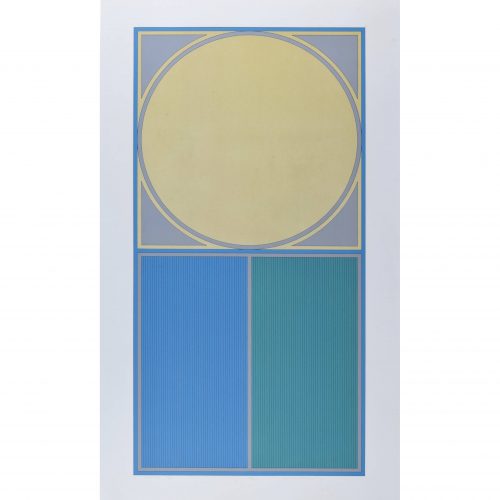
Gordon House (1932 - 2004)
Circle E
Lithograph 86 x 45 cm Signed, numbered 48/75, and titled in pencil below the plate. An excellent example of Gordon House's work: a modern design, influenced by art deco, in blue and yellow. Gordon House was born in Pontardawe, South Wales in 1932 and studied at Luton and St. Albans Schools of Art. He began working for advertising agencies in the 1950s and became a full-time artist in 1961, exhibiting several solo shoes. He designed for several leading London galleries, the Ashmolean Museum in Oxford, and popular bands such as the Beatles and the Rolling Stones. Several dozen Gordon House prints are held by the Tate. Condition: very good; backed to board. If you are interested, please email info@manningfineart.co.uk or call us on 07929 749056. Click here for other abstract lithographs by Gordon House. -
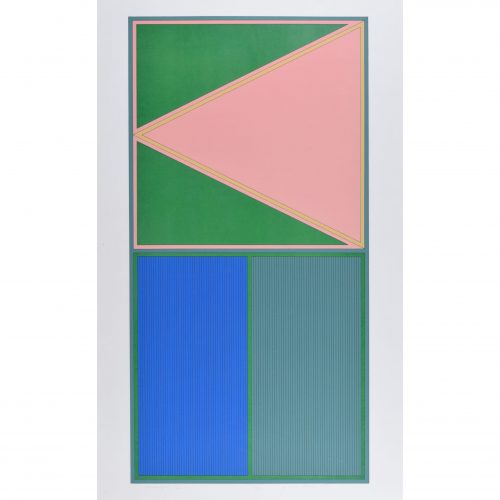
Gordon House (1932 - 2004)
Triangle D
Lithograph 86 x 45 cm Signed and titled in pencil below the plate. An excellent example of Gordon House's work: a modern design in tones of green, pink, and blue. Gordon House was born in Pontardawe, South Wales in 1932 and studied at Luton and St. Albans Schools of Art. He began working for advertising agencies in the 1950s and became a full-time artist in 1961, exhibiting several solo shoes. He designed for several leading London galleries, the Ashmolean Museum in Oxford, and popular bands such as the Beatles and the Rolling Stones. Several dozen Gordon House prints are held by the Tate. Condition: very good; backed to board. If you are interested, please email info@manningfineart.co.uk or call us on 07929 749056. Click here for other abstract lithographs by Gordon House. -
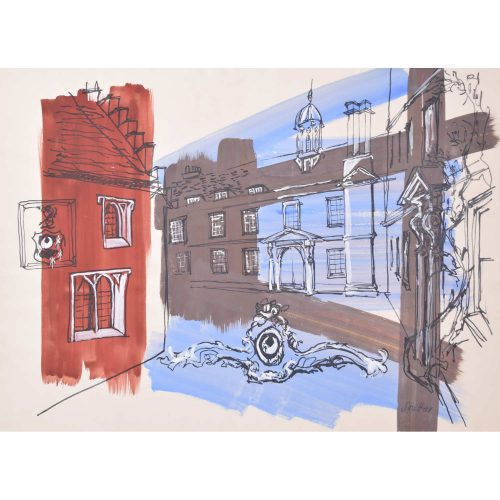
Margaret Souttar (1914 - 1987)
Trinity Hall, Cambridge I
Acrylic paint 55 x 76 cm Signed in pencil lower right. Souttar was a Scottish painter and printmaker known for her images of town- and cityscapes. In the early 1960s, she was commissioned to produce a series of prints of the Cambridge colleges. She captures the modernity and optimism of 1960s Cambridge; the fact that a female artist was commissioned to create the prints reflects the changing attitudes of the University towards women. Trinity Hall was one of the first Cambridge colleges to admit women as students - it did not do so until 1976. Provenance: the artist's studio sale. Condition: generally very good, a few handling marks. If you are interested, please email info@manningfineart.co.uk or call us on 07929 749056. Click here for other views of Trinity Hall. -
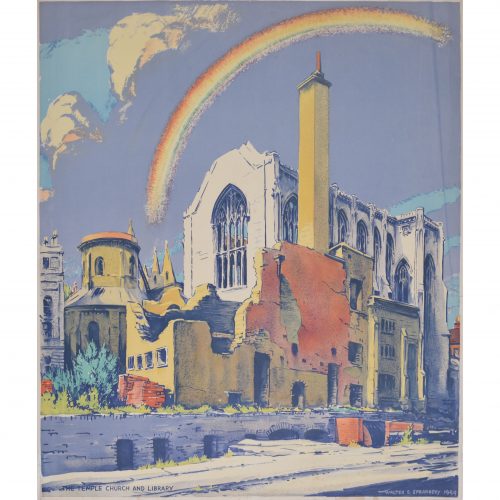
Walter Ernest Spradbery (1889 - 1969)
Temple Church and Library after Bombardment (1944)
Lithograph 66 x 57 cm Walter Spradbery's poster for the London Underground depicting a bombed Temple Church; a rainbow strikes hopefully out of the church's remains, and the sun shines on the golden stone of the building. The full poster bears the legend 'The Proud City' above Spradbery's design, and, beneath it, a quote from Charles Lamb: 'So may the winged horse, your ancient badge and cognisance, still flourish!'. This is a fantastic piece of British and London history, as well as a fantastically designed poster by a notable 20th century artist. The London Transport Museum has a copy of the poster, reference 1983/4/5751. 'The Proud City' was a series of six posters, all designed by Spradbery. They were commissioned by London Transport in 1944 as a defiant celebration of London's surviving the Blitz, and each poster also included a literary quotation. Walter Ernest Spradbery was a designer, painter, and poet who lived through the First and Second World Wars. He produced posters for LNER, Southern Railways, and London Transport, and was noted for his fascination with architecture and landscape. He studied, and later taught, at the Walthamstow School of Art. He was a pacifist and campaigned for nuclear disarmament, serving in the Medical Corps during the First World War and painting scenes of warfare for its duration, as well as during the Second World War. His anti-war stance and the horrors he had witnessed as a medic fed into his post-war poster design, especially 'The Proud City' poster series. Condition: generally very good. If you’d like to know more, please email info@manningfineart.co.uk or call us on 07929 749056. -
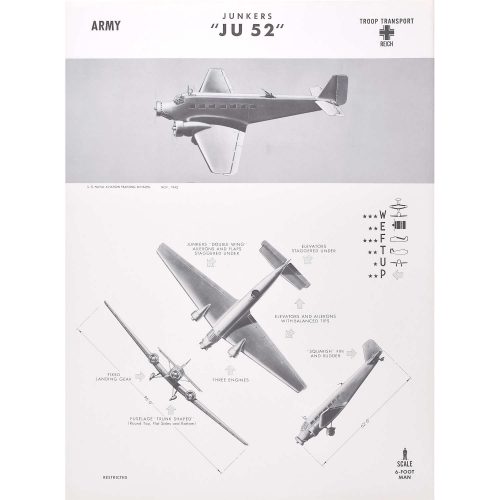
Junkers "JU 52"
Aeroplane identification poster, published 1942 63 x 47 cm A particularly unusual style of aeroplane identification poster, owing to the very arty images. Most such posters rely on very plain silhouettes, this series - and we have several in this series; view them here - have a much more arty approach to the task with shading and an interesting angle view. The Junkers Ju 52/3m (nicknamed Tante Ju ("Aunt Ju") and Iron Annie) was a transport aircraft that was designed and manufactured by German aviation company Junkers. Development of the Ju 52 commenced during 1930, headed by German aeronautical engineer Ernst Zindel. Its maiden flight was on 13 October 1930. Following the rise of Nazi Germany, thousands of Ju 52s were procured as a staple military transport of the nation. The Ju 52 was in production between 1931 and 1952. In a civilian role, it flew with over 12 airlines, including Swissair and Deutsche Luft Hansa, as both a passenger carrier and a freight hauler. In a military role, large numbers flew with the Luftwaffe, being deployed on virtually all fronts of the Second World War as a troop and cargo transport; it was also briefly used as a medium bomber. Additionally, the type was deployed by other nation''s militaries in conflicts such as the Spanish Civil War, the Chaco War, and the Portuguese Colonial War. During the postwar era, the Ju 52 had a lengthy service life with numerous military and civilian operators; large numbers were still in use by the 1980s. Even in the 21st century, several aircraft have remained operational, typically used for purposes such as heritage aviation displays and aerial sightseeing. Condition: generally very good. If you are interested, please email info@manningfineart.co.uk or call us on 07929 749056. -
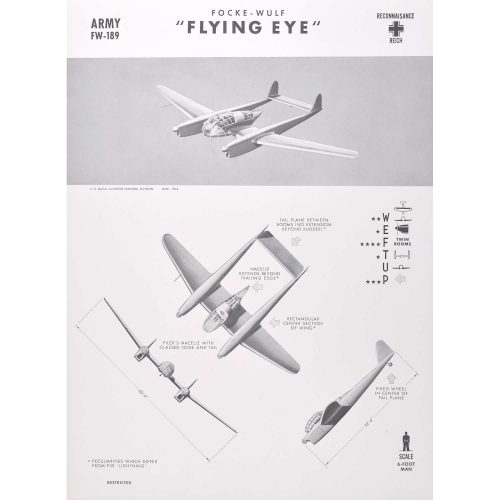
Army FW-189 "Flying Eye"
Aeroplane identification poster, published 1942 63 x 47 cm A particularly unusual style of aeroplane identification poster, owing to the very arty images. Most such posters rely on very plain silhouettes, this series - and we have several in this series; view them here - have a much more arty approach to the task with shading and an interesting angle view. The Focke-Wulf Fw 189 Uhu ("Eagle Owl") was a German twin-engine, twin-boom, three-seat tactical reconnaissance and army cooperation aircraft. It first flew in 1938, entered service in 1940 and was produced until mid-1944. It was nicknamed the “Flying Eye.” Patrolling the vast flatlands of Ukraine and Belarus, the Flying Eye was used extensively on the Eastern Front with great success. It was nicknamed "Rama" ("frame") by Soviet forces, in reference to its distinctive tailboom and stabiliser shapes, which gave it its characteristic quadrangular appearance. Despite its low speed, the Fw 189's manoeuvrability made it a difficult target for attacking Soviet fighters. When attacked, the Flying Eye was often able to out-turn enemy fighters by simply flying in a tight circle. Condition: generally very good. If you are interested, please email info@manningfineart.co.uk or call us on 07929 749056. -
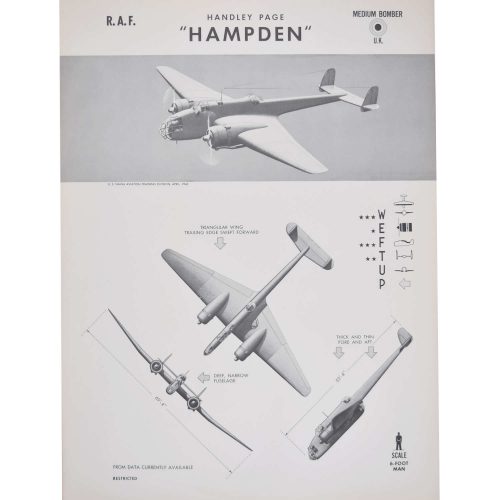
Royal Air Force Handley Page "Hampden" Bomber
Aeroplane identification poster, published 1943 63 x 47 cm A particularly unusual style of aeroplane identification poster, owing to the very arty images. Most such posters rely on very plain silhouettes, this series - and we have several in this series; view them here - have a much more arty approach to the task with shading and an interesting angle view. The Handley Page HP.52 Hampden is a British twin-engine medium bomber that was operated by the Royal Air Force (RAF). It was part of the trio of large twin-engine bombers procured for the RAF, joining the Armstrong Whitworth Whitley and Vickers Wellington. The Hampden was powered by Bristol Pegasus radial engines but a variant known as the Handley Page Hereford had in-line Napier Daggers. The Hampden served in the early stages of the Second World War, bearing the brunt of the early bombing war over Europe, taking part in the first night raid on Berlin and the first 1,000-bomber raid on Cologne. When it became obsolete, after a period of mainly operating at night, it was retired from RAF Bomber Command service in late 1942. By 1943, the rest of the trio were being superseded by the larger four-engined heavy bombers such as the Avro Lancaster. Condition: generally very good. If you are interested, please email info@manningfineart.co.uk or call us on 07929 749056. -
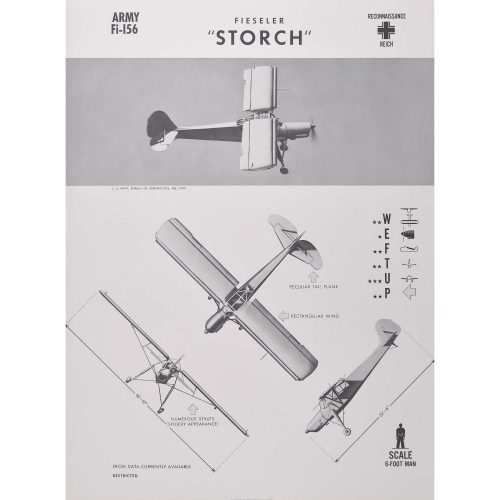
Army Fi-156 Fieseler "Storch"
Aeroplane identification poster, published 1944 63 x 47 cm A particularly unusual style of aeroplane identification poster, owing to the very arty images. Most such posters rely on very plain silhouettes, this series - and we have several in this series; view them here - have a much more arty approach to the task with shading and an interesting angle view. The Fieseler Fi 156 Storch, meaning "stork", was a small German liaison aircraft built by Fieseler before and during World War II. It was notable for its excellent short-takeoff-and-landing performance and low stall speed of 31 mph.The Douglas Skymaster was a four-engine transport aircraft used by the United States Army Air Forces in World War II and the Korean War. Like the Douglas C-47 Skytrain (the Skytrain poster from the same series is also available in our storefront), the Skymaster was derived from a civilian airliner, the Douglas DC-4. The Storch was deployed in all European and North African theatres of World War II. In addition to its liaison function, a number were used to fly a battalion of Infantry Regiment Grossdeutschland behind enemy lines during the invasion of Belgium. In 1943, the Storch played a role in Operation Eiche, the rescue of deposed Italian dictator Benito Mussolini from a boulder-strewn mountain-top near the Gran Sasso. Even though the mountain was surrounded by Italian troops, German commando Otto Skorzeny and 90 paratroopers used gliders to land on the peak and quickly captured it. However, the problem of how to get back off remained. A Focke-Achgelis Fa 223 helicopter was sent, but it broke down en route. Instead, pilot Heinrich Gerlach flew over in a Storch. After Mussolini and Skorzeny had boarded the aircraft, the Storch took off to 250 ft, even though the aircraft was overloaded. A Storch was the last aircraft shot down by the Allies on the Western Front. Condition: generally very good. If you are interested, please email info@manningfineart.co.uk or call us on 07929 749056. -
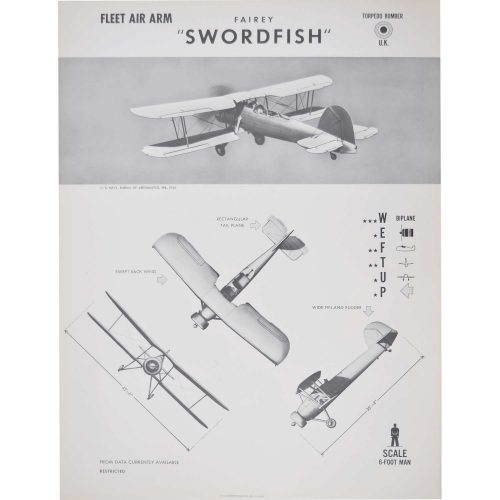
Fairey Swordfish
Aeroplane identification poster, published 1942 63 x 47 cm A particularly unusual style of aeroplane identification poster, owing to the very arty images. Most such posters rely on very plain silhouettes, this series - and we have several in this series; view them here - have a much more arty approach to the task with shading and an interesting angle view. The Fairey Swordfish is a biplane torpedo bomber designed by the Fairey Aviation Company. Originating in the early 1930s, the Swordfish, nicknamed "Stringbag", was operated by the Fleet Air Arm of the Royal Navy, it was also used by the Royal Air Force (RAF), as well as several overseas operators, including the Royal Canadian Air Force (RCAF) and the Royal Netherlands Navy. It was initially operated primarily as a fleet attack aircraft. During its later years, the Swordfish became increasingly used as an anti-submarine and training platform. The type was in frontline service throughout the Second World War. Despite being obsolete by 1939, the Swordfish achieved some spectacular successes during the war. Notable events included sinking one battleship and damaging two others of the Regia Marina (the Italian Navy) during the Battle of Taranto, and the famous attack on the Bismarck, which contributed to her eventual demise. By the end of the war, the Swordfish held the distinction of having caused the destruction of a greater tonnage of Axis shipping than any other Allied aircraft. The Swordfish remained in front-line service until V-E Day, having outlived multiple aircraft that had been intended to replace it in service. Condition: generally very good. If you are interested, please email info@manningfineart.co.uk or call us on 07929 749056. -
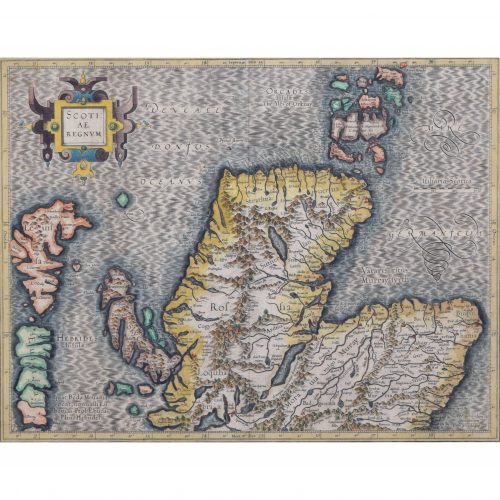
Gerardus Mercator (1512 - 1594)
Map of the North of Scotland (1683)
Engraving with later hand colouring 35 x 45 cm A fantastically characterful and detailed map engraving of the North of Scotland from 1683. The highly detailed and beautifully coloured map is inscribed to the reverse with a description of the parts of Scotland illustrated, called the ''Troisieme Table d''Escosse''. The map comes from the 1683 French edition of Gerardus Mercator''s Atlas Major, which was first published in 1585. Gerardus Mercator was the Flemish father of mapmaking. He was a skilled geographer, cosmographer and cartographer and is most renowned for creating the 1569 world map based on a new projection which represented sailing courses of constant bearing (rhumb lines) as straight lines - an innovation that is still employed in today''s nautical charts. Mercator was a highly influential pioneer in the history of cartography and is generally considered one of the founders of the Netherlandish school of cartography and geography. He is also widely considered the most notable figure of the school. In his own day, he was a notable maker of globes and scientific instruments. In addition, he had interests in theology, philosophy, history, mathematics and geomagnetism. He was also an accomplished engraver and calligrapher. Unlike other great scholars of the age, he travelled little and his knowledge of geography came from his library of over a thousand books and maps, from his visitors and from his vast correspondence (in six languages) with other scholars, statesmen, travellers, merchants and seamen. Mercator''s early maps were in large formats suitable for wall mounting but in the second half of his life, he produced over 100 new regional maps in a smaller format suitable for binding into his Atlas of 1595. This was the first appearance of the word Atlas in reference to a book of maps. However, Mercator used it as a neologism for a treatise (Cosmologia) on the creation, history and description of the universe, not simply a collection of maps. He chose the word as a commemoration of the Titan Atlas, "King of Mauretania", whom he considered to be the first great geographer. Mercator wrote on geography, philosophy, chronology and theology. All of the wall maps were engraved with copious text on the region concerned. As an example, the famous world map of 1569 is inscribed with over five thousand words in fifteen legends. Condition: a little spotting, primarily to margins. If you’d like to know more, please email info@manningfineart.co.uk or call us on 07929 749056. -
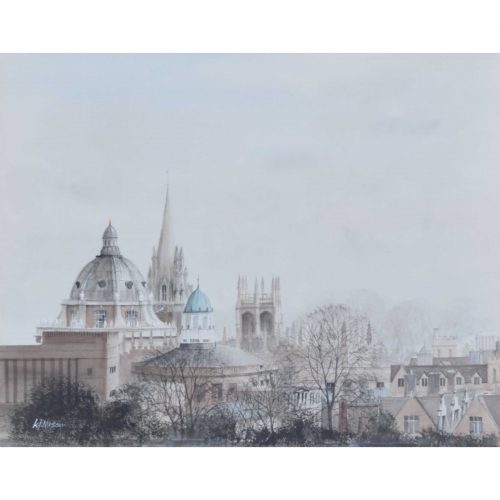
Ken Messer (1931 - 2018)
Dreaming Spires
Watercolour 30 x 38 cm Signed lower left. Oxford's skyline, including the Radcliffe Camera, the spire of University Church of St Mary the Virgin, and Magdalen Tower, is silhouetted against the grey sky of a winter day. The trees in the foreground are stark and black. Messer's depiction of Oxford's dreaming spires is an outstanding architectural record of the city's - and University's - most remarkable buildings. The painter and draughtsman Ken Messer is closely related to Oxford and its architecture in several ways. Born in Newport, South Wales, he was educated at the City of Oxford High School for Boys in Oxford, and then spent six years working as an accountant in Oxford. He then joined British Overseas Airways Corporation (BOAC) as a steward, flying internationally. Injury due to a car accident during the 1960s meant that he joined the design department of Pergamon Press in Oxford at the age of 33. Six years later, he was appointed to the position of studio manager, in charge of art and design. In 1974, Messer left Pergamon Press to become a freelance graphic designer. He started painting more watercolours, becoming a full-time artist. During the 1980s, his ink drawings were regularly published in the Oxford Times. He has sometimes been called "The Oxford Artist" because of his large number of works depicting Oxford. He and his wife Dilys lived at first in Richmond upon Thames and then in Abingdon, just south of Oxford. Messer's work has been shown at the Mall Galleries for the annual exhibitions of the Royal Institute of Painters in Water Colours annual exhibitions. Condition: excellent. If you’d like to know more, please email info@manningfineart.co.uk or call us on 07929 749056. -
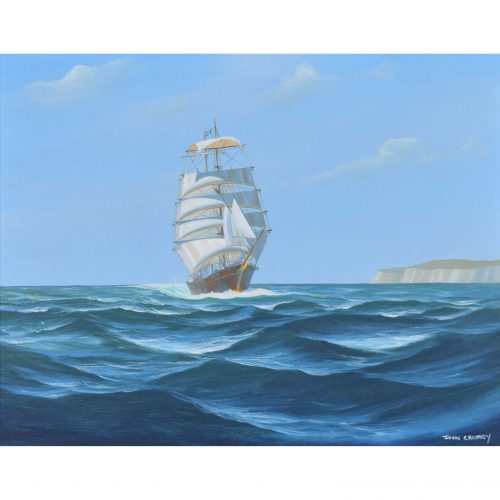
John Cromby (20th century)
Berean
Oil on board 38 x 49 cm Signed lower right. The Berean emerges from the horizon between a choppy sea and blue sky studded with clouds. The Berean was built by William Pile of Sunderland for Thomas B Walker of London in 1869, and was one of the fastest ships on the London-Tasmania run. The Berean was inward-bound from Langesund, Norway, with a cargo of ice, when she was struck by a foreign steamship and foundered on the 8th April 1910. In Cromby's painting, a grey-green headland emerges from the right of the picture. Cromby was a Liverpool-based artist, renowned for his paintings of Liverpool docks. Condition: excellent. If you’d like to know more, please email info@manningfineart.co.uk or call us on 07929 749056. -
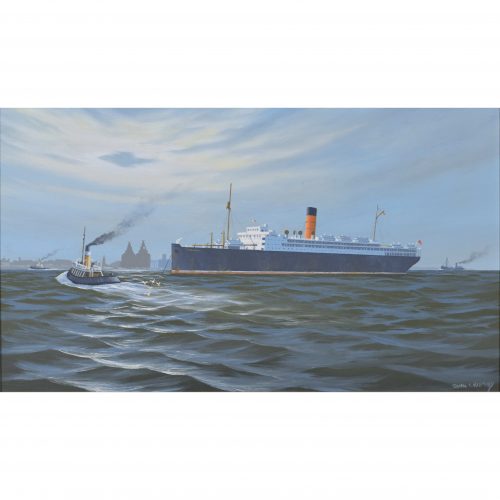
John Cromby (20th century)
A Passenger Ship in Liverpool Harbour
Oil on board 34 x 59 cm Signed lower right. A liner steers between a bright blue sky and a deep blue sea. Small steamships sail nearby, and seagulls wind their way among the various vessels. In the background, Liverpool's skyline is silhouetted. Cromby was a Liverpool-based artist, renowned for his paintings of Liverpool docks. Condition: excellent. If you’d like to know more, please email info@manningfineart.co.uk or call us on 07929 749056. -

Gordon House (1932 - 2004)
Triangle E
Lithograph 86 x 45 cm Signed and titled in pencil below the plate. An excellent example of Gordon House's work: a modern design in several tones of blue. Gordon House was born in Pontardawe, South Wales in 1932 and studied at Luton and St. Albans Schools of Art. He began working for advertising agencies in the 1950s and became a full-time artist in 1961, exhibiting several solo shoes. He designed for several leading London galleries, the Ashmolean Museum in Oxford, and popular bands such as the Beatles and the Rolling Stones. Several dozen Gordon House prints are held by the Tate. Condition: very good. Mounted to board. If you’d like to know more, please email info@manningfineart.co.uk or call us on 07929 749056. -
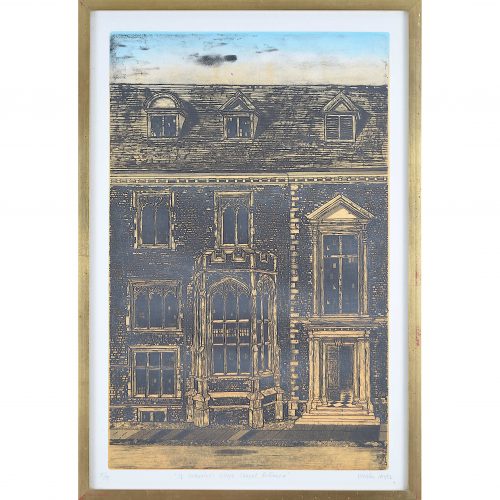
Walter Hoyle (1922-2000)
St Catharine's College, Cambridge (1956-66)
Linocut 59 x 39 cm Signed lower right; inscribed and numbered 35/75 in pencil. Hoyle trained at Beckenham School of Art and the Royal College of Art. At the latter he was strongly influenced by Edward Bawden, one of Britain’s greatest linocut printers. Bawden had been commissioned by the 1951 Festival of Britain to produce a mural for the South Bank, and chose Hoyle to assist on account of his great talent. Hoyle moved to Great Bardfield in Essex, becoming a part of the Great Bardfield group of artists; diverse in style, they created figurative work, in stark contrast to the abstract art of the St Ives artists at the opposite end of the country. Hoyle taught at St Martin’s School of Art from 1951-60, the Central School of Arts and Crafts from 1960-64, and the Cambridge School of Art from 1964-1985, during which time he launched Cambridge Print Editions. His work is held in the collections of the Tate Gallery, the Victoria and Albert Museum, The British Museum, Kettle’s Yard and the Fry Art Gallery. Condition: very good. -
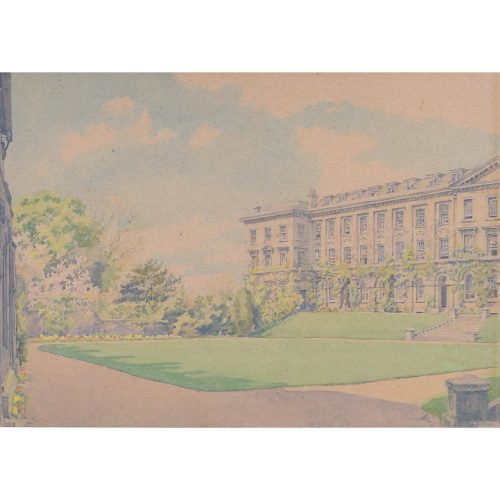
Bernard Cecil Gotch (1876-1964)
Worcester College, Oxford
Watercolour 26 x 38 cm Signed lower right. Gotch's watercolour highlights the verdant lawns and leafy foliage of one of Oxford's greenest and most beautiful colleges. Bernard Cecil Gotch was a Winchester born artist who is best known for his atmospheric watercolours of Britain's towns and cities (most notably Oxford). He moved to Oxford in 1927, painting many watercolours of the interiors and exteriors of Oxford’s many buildings. His works concentrate on the grand exteriors and interiors of the University's colleges, and he exhibited frequently - including an exhibition every term at Oriel College. His first notable commission was for the publisher Methuen, illustrating 'A Shepherd’s Life' by W H Hudson. Whilst in London he was invited to illustrate a book on the Public Schools of England (which was sadly never completed). He exhibited watercolours at the Fine Art Society and Lincolns Inn, and also exhibited at the Royal Academy. In 1952 Gotch was given an Honorary MA by the University of Oxford, and, after his death in 1963, a memorial was held for him at Oriel. Provenance: detailed on label to reverse. Condition: generally very good, painted on 'rough' paper; signed and titled to label. -
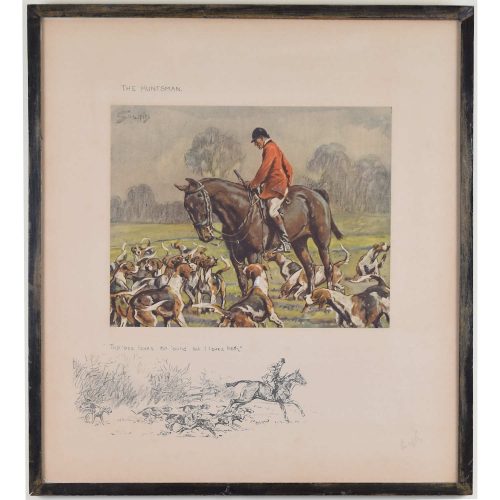
Charles "Snaffles" Johnson Payne (1884-1967)
The Huntsman: "The 'oss loves the 'ound but I loves both"
Lithograph 47 x 43 cm Signed in pencil with Snaffles' bit blindstamp, in original 1/2" frame. Snaffles was one of the foremost sporting artists of his era, publishing many popular prints such as these: hunting pictures, racing scenes, and military subjects. Snaffles' distinctive drawing style is emphasised by his 'remarque' - sketches in the margin - and his witty titles. Condition: very good. Small chip to bottom centre of frame. -
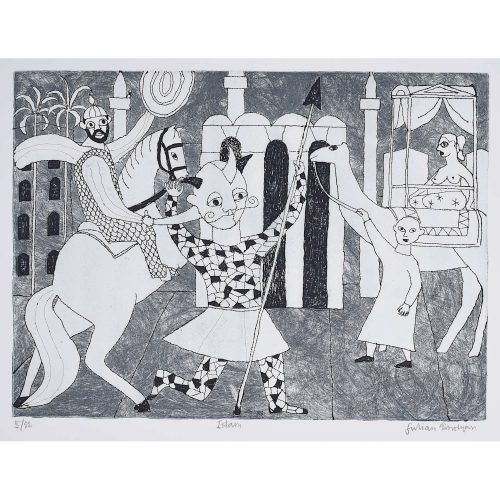 Julian Trevelyan (1910-1988) Islam Etching 35 x 48 cm (sheet size 55 x 68 cm) Nephew of the historian G M Trevelyan, Julian Trevelyan was educated at Bedales and then at Trinity College, Cambridge, where he read English. After moving to Paris, Trevelyan studied engraving at Stanley William Hayter’s school, working alongside artists such as Max Ernst, Joan Miro and Pablo Picasso. He married the potter Ursula Darwin in 1934, and in 1935 they moved to Hammersmith, buying Durham Wharf beside the River Thames which was Trevelyan’s studio – and home – for the rest of his life. His wartime service was – like so many artists – as a camoufleur. A Royal Engineer from 1940-43, he served in North Africa and Palestine, forcing the German Afrika Korps to use resources against a dummy army whilst real tanks were disguised as more harmless equipment. In the desert, nothing could be hidden - but it could be disguised. Following the dissolution of his marriage in 1950, he married the painter Mary Fedden. Teaching at Chelsea School of Art, Trevelyan eventually became head of the Etching Department and his pupils included David Hockney and Peter Ackroyd. Condition: mounted to board.
Julian Trevelyan (1910-1988) Islam Etching 35 x 48 cm (sheet size 55 x 68 cm) Nephew of the historian G M Trevelyan, Julian Trevelyan was educated at Bedales and then at Trinity College, Cambridge, where he read English. After moving to Paris, Trevelyan studied engraving at Stanley William Hayter’s school, working alongside artists such as Max Ernst, Joan Miro and Pablo Picasso. He married the potter Ursula Darwin in 1934, and in 1935 they moved to Hammersmith, buying Durham Wharf beside the River Thames which was Trevelyan’s studio – and home – for the rest of his life. His wartime service was – like so many artists – as a camoufleur. A Royal Engineer from 1940-43, he served in North Africa and Palestine, forcing the German Afrika Korps to use resources against a dummy army whilst real tanks were disguised as more harmless equipment. In the desert, nothing could be hidden - but it could be disguised. Following the dissolution of his marriage in 1950, he married the painter Mary Fedden. Teaching at Chelsea School of Art, Trevelyan eventually became head of the Etching Department and his pupils included David Hockney and Peter Ackroyd. Condition: mounted to board. -
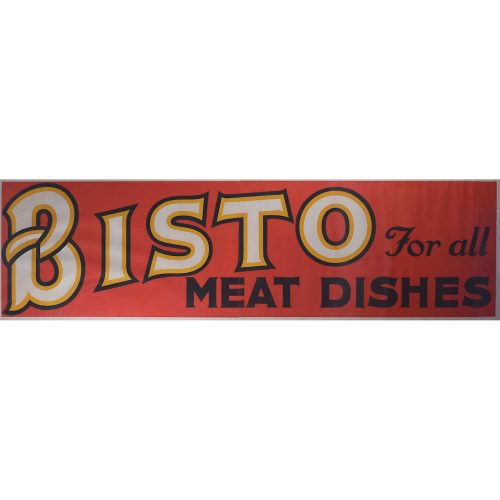
'Bisto for all Meat Dishes'
Original vintage poster 55 x 202 cm This original vintage poster is an excellent opportunity to acquire a piece of British advertising history. Bisto is an instantly recognisable brand today, and has been throughout the 20th century; the catchphrase on the poster here, "Bisto for all meat dishes" was used in the 1950s. The first Bisto product, in 1908, was a meat-flavoured gravy powder which rapidly became a bestseller in the UK. It was added to gravies to thicken them and give a richer taste and aroma. Invented by Messrs Roberts & Patterson, it was named "Bisto" because it "Browns, Seasons and Thickens in One". As of 2005, Bisto Gravy Granules had a British market share of over 70%. Nearly all British grocery outlets stock a Bisto product. -

David Loggan (1634-1692)
Queen's College, Oxford (1674)
Engraving, 30 x 41cm Loggan was born to English and Scottish parents, and was baptised in Danzig in 1634. After studying engraving in Danzig with Willem Hondius (1598-1652 or 1658), he moved to London in the late 1650s, going on to produce the engraved title-page for the folio 1662 Book of Common Prayer. He married in 1663 and moved to Nuffield in Oxfordshire in 1665. Loggan was appointed Public Sculptor to the nearby University of Oxford in the late 1660s, having been commissioned to produce bird’s-eye views of all the Oxford colleges. He lived in Holywell Street as he did this. The 'Oxonia Illustrata' was published in 1675, with the help of Robert White (1645-1704). Following its completion, Loggan began work on his equivalent work for Cambridge; the 'Cantabrigia Illustrata' was finally published in 1690, when he was made engraver to Cambridge University. The 'Oxonia Illustrata' also includes an engraving of Winchester College (Winchester and New College share William of Wykeham as their founder) whilst the 'Cantabrigia Illustrata' includes one of Eton College (which shares its founder, Henry VIII, with King’s College). Bird’s-eye views from this era required a particular talent as an architectural perspectivist; it was not until 1783 that it became possible for artists to ascend via hot air balloons and view the scenes they were depicting from above. Loggan thus had to rely on his imagination in conceiving the views. Loggan’s views constitute the first accurate depictions of the two Universities, in many ways unchanged today. Whilst the Oxford engravings were produced in reasonable numbers and ran to a second edition by Henry Overton (on thicker paper and with a plate number in Roman numerals in the bottom right-hand corner), those of Cambridge were printed in much smaller numbers. The Dutchman Pieter van der Aa published some miniature versions of the engravings for James Beverell’s guidebook to the UK, 'Les Delices de la Grande Bretagne' (c. 1708). The contemporary artist Andrew Ingamells (b.1956) has produced a highly-acclaimed series of etchings which bring Loggan’s original vision up to date. Condition: good, crease bottom right hand corner. If you’d like to know more, please email info@manningfineart.co.uk or call us on 07929 749056. -

Edwin La Dell ARA (1914-1970)
St John's College Cambridge
Signed and titled Lithograph (1959)35x46.5cm
Click here for biographical details and other works by the artist. If you are interested email info@manningfineart.co.ukor call us on 07929 749056. Condition: Good. -
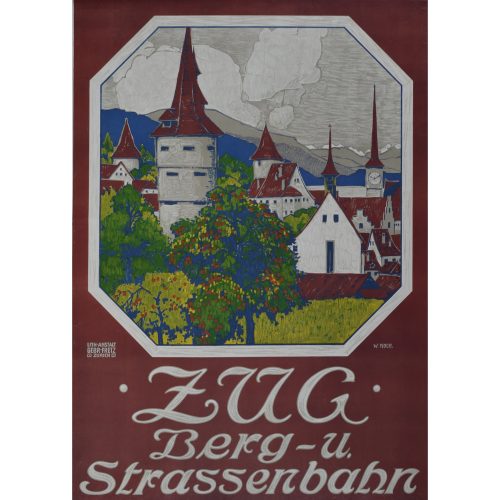
Walther Koch (1875-1915) Zug Berg und Strassenbahn
Original lithographic poster (1914) 40x30" Printed in Zurich by Anstalt Gebr Fretz If you are interested email info@manningfineart.co.uk or call us on 07929 749056. Condition: Excellent. -
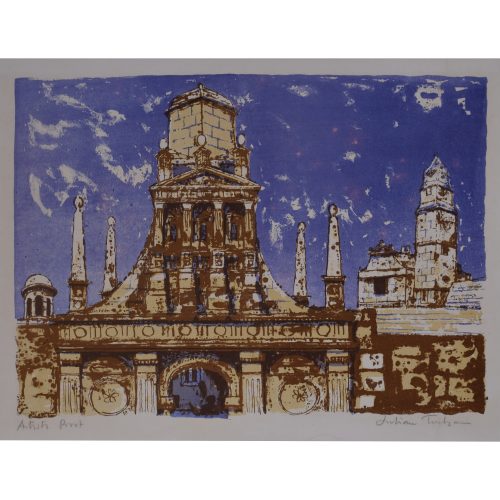
Julian Otto Trevelyan, RA (1910 -1988) Caius College II, Cambridge (1959/1962)
Signed by the artist and inscribed in pencil Artist's Proof, aside from the edition of 70. The edition consisted of 70 numbered proofs and 30 artist’s proofs. We also have listed one of the 70 numbered proof prints, which is in a purple colourway - rather than the blue here. 37x51cm (14.5×20 inches) This comes from Julian Trevelyan’s Cambridge Suite which consisted of 10 lithographs: Caius College, Caius College II, Christ’s College, Corpus Christi College, Downing College, Emmanuel College, Jesus College, Peterhouse, St Catharine’s College and Sidney Sussex College. The Government Art Collection has copies of several of the prints in this series. If you are interested email info@manningfineart.co.uk or call us on 07929 749056. Condition: Good. Old crease that runs from top to bottom has been restored and is barely perceptible - see photograph. -
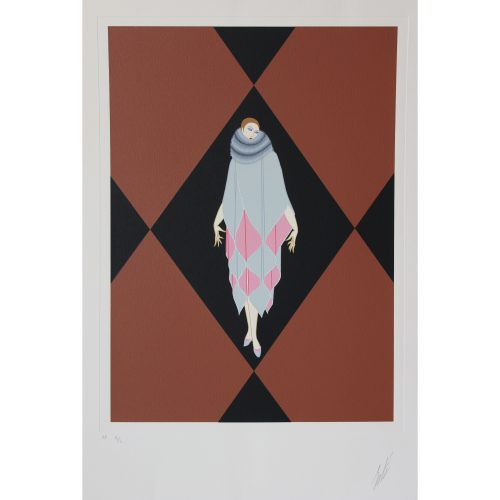
Erté (Romain de Tirtoff) (1892-1990) 'Manhattan Mary IV'
Serigraph (Artist's Proof IL/L) Signed in pencil 70 x 56cm (sheet) 41.5 x 30.5cm (plate) The Russian born Romain de Tirtoff moved to Paris around 1912 to work as a designer, choosing the pseudonym ‘Erté’ based on the French pronunciation of his initials. He produced fashion plates for the designer Paul Poiret and signed a contract with Harper’s Bazaar that saw him design over 200 covers for the magazine. Costume and stage design followed in the 1920s, for the Folies Bergeres and similar revues in Paris, then in Hollywood for Louis B. Mayer. Erté’s distinctive and elegant style came to epitomise the Art Deco era; it is characterised by a combination of sharp geometric line - like the harlequin background to this print - strong colour planes and images of fashionable modern women with close-cropped hair and asymmetric hemlines. Art Deco enjoyed a revival in the 1960s, and it was from this point that limited edition prints began to be produced from Erté’s designs. ‘Manhattan Mary’ was a Broadway musical which opened at the Apollo Theatre, New York in September 1927, with set and costume designs by Erté. If you are interested email info@manningfineart.co.uk or call us on 07929 749056. Condition: Excellent. -
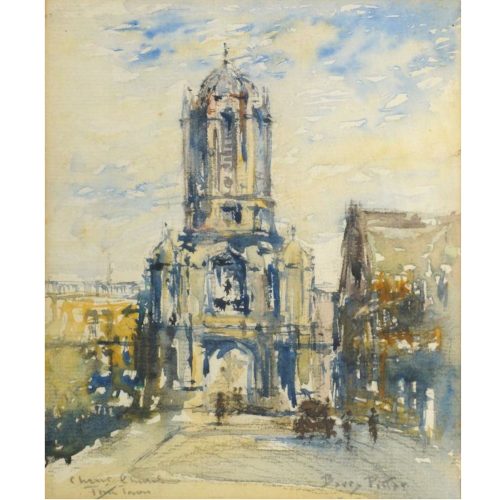
J F Barry Pittar (British 1880-1948) Tom Tower, Christ Church Oxford
Watercolour 15.5x13cm If you are interested email info@manningfineart.co.uk or call us on 07929 749056. Condition: Good. -
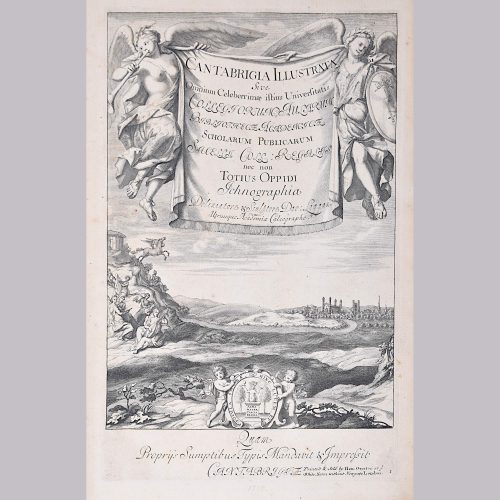
David Loggan (1634-1692) View of Cambridge
Engraving after 1690, this is a slightly later Henry Overton printing, shortly after 1700 35x51cm Baptised in Danzig in 1634 Loggan's parents were English and Scottish. Studying engraving in Danzig with Willem Hondius (1598-1652 or 1658) he moved to London in the late 1650s producing the engraved title-page for the folio 1662 Book of Common Prayer. Marrying in 1663 he moved to Nuffield, Oxfordshire in 1665 to avoid the Plague and was in 1668/9 appointed Public Sculptor to the nearby University of Oxford having been commissioned to produce bird’s-eye views of all the Oxford Colleges. He lived in Holywell Street as he did this. Oxonia illustrata was published in 1675, with the help of Robert White (1645-1704). Following its completion he commenced work on his equivalent work for Cambridge, Cantabrigia Illustrata which was finally published in 1690 when he was made engraver to Cambridge University. Oxonia illustrata also includes an engraving of Winchester College (sharing its founder – William of Wykeham – with New College) whilst Cantabrigia illustrata includes one of Eton College (which shares its founder – Henry VIII – with King’s College). Bird’s-eye views required a particular talent as an architectural perspectivist of that era as it was not until 1783 that the first living thing (a sheep, named Montauciel ‘climb to the sky’) was sent aloft by the Mongolfier brothers in a balloon. Loggan thus had to rely on his imagination in conceiving the views. Loggan’s views constitute the first accurate depictions of the two Universities, in many ways unchanged today. Whilst the Oxford engravings were produced in reasonable numbers and ran to a second edition by Henry Overton (on thicker paper and with a plate number in the bottom right-hand corner), those of Cambridge were printed in smaller numbers and it is thought largely no second edition was produced, although this frontispiece proudly claims to have been published by Overton and a pencil note on the print suggests 1715 as a date. The Dutchman Pieter van der Aa published some miniature versions of the engravings for James Beverell’s guidebook to the UK Les Delices de la Grande Bretagne c. 1708. Edmund Hort New (1871-1931) produced a series of pen-and-ink drawings of views of Oxford that paid homage to Loggan showing the development of the city in the following two hundred years. They were turned into photoengravings by Emery Walker who published the series between . Probably no more than two hundred of each engraving were produced and the plates were destroyed in the blitz. The contemporary artist Andrew Ingamells (b.1956) has produced a highly-acclaimed series of etchings again bringing Loggan’s vision up to date. If you are interested email info@manningfineart.co.uk or call us on 07929 749056. Condition: Good. Some age toning as visible in photograph; usual handling wear and marks to edges. -
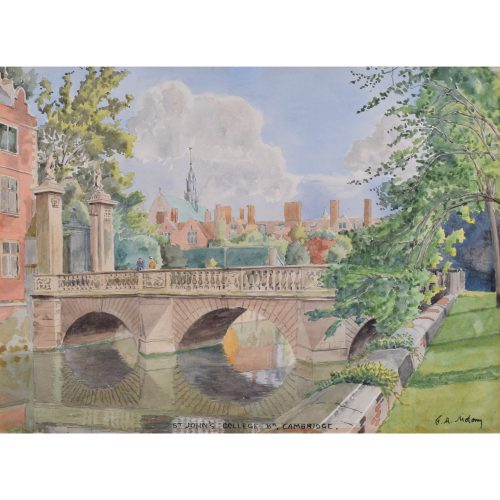
Major F A Molony (c. 1865 - ?) St John's College, Cambridge
watercolour, probably early twentieth century 7x10" Molony was member of the Royal Engineers and a talented watercolourist. 25 July 1882: Promoted to the rank of Lieutenant. 1885: Served in the 10th Company, Royal Engineers during the Suakin Expedition. 22 October 1890: Promoted to the rank of Captain. 27 October 1899: Promoted to the rank of Major. Fought at Battle of Pieters Hill, in the Anglo-Boer war. 23 June 1902: Mentioned in Lord Kitchener's Despatches.m, If you are interested email info@manningfineart.co.uk or call us on 07929 749056. Condition: Good. -
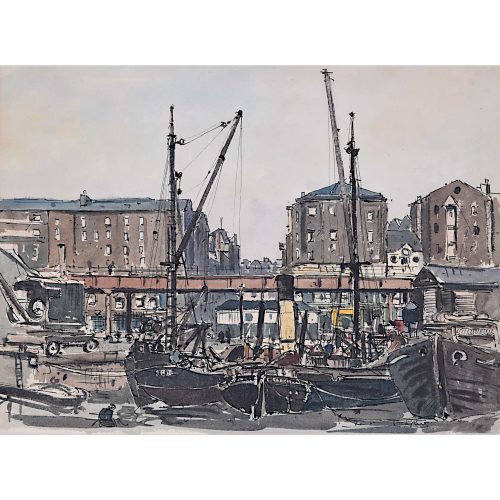
Claude Muncaster (1903-1974) Liverpool Docks
Dated 1928 Inscribed to reverse Watercolour 28x37cm Muncaster's watercolours capture the English countryside feel with great competence and feeling. Here he records the docks at Liverpool, a busy scene with splashes of bright paint enlivening the otherwise dull smoky port. Liverpool Claude Grahame Muncaster, RWS, ROI, RBA, SMA was the son of Oliver Hall RA. At the age of fifteen his career as a landscape painter began, and he soon took to the seas, spending the 1920s and 30s travelling the world with his sketchbook in a series of vessels. With the outbreak of war and he joined the RNVR training as a navigator. Having left school at fifteen his mathematics was very weak and it was a relief for all when his artistic talents meant he was recruited as a camofleur. A master of capturing seascapes he was therefore able to hide huge ships ‘in plain sight’ with clever disguises. After the war he painted for the Royal Family and was a frequent guest at Sandringham. Claude Muncaster was a watercolourist known for his landscapes and maritime scenes. He was born Grahame Hall, the son of the Royal Academician Oliver Hall who taught his son to paint from an early age; Grahame first exhibited his work aged 15 and a few years later was showing at the RA. However, he adopted the name Claude Muncaster in 1922 to dissociate his career from that of his father. Muncaster’s primary choice of subject matter came from a genuine love of the sea. He made several long-distance sea voyages, including one around the Horn as a deckhand in the windjammer Olivebank in 1931, which he described in ‘Rolling Round the Horn’, published in 1933. Armed with a sketchbook, his aim was to be able to ‘paint ships and the sea with greater authority’. This he certainly achieved, perfectly capturing the limpid first light of morning over the Port of Aden, the choppy rain-grey waters of the Bay of Biscay and a streak of sunlight through gathering storm clouds at dusk in Exeter. He became an Associate of the Royal Watercolour Society in 1931 and was a founder member, and later President, of the Royal Society of Marine Artists. During the Second World War, Muncaster served in the Royal Naval Volunteer Reserve (RNVR) from 1940-44, training as a navigator before going on to advise on the camouflage of ships, and also worked as an official war artist. In ‘Still Morning at Aden’ (1944) he depicts Allied warships in this safe anchorage in the Middle East; the back is stamped with Admiralty approval. In 1946-7 he was commissioned by the Queen to produce watercolours of the royal residences at Windsor, Sandringham and Balmoral; the Duke of Edinburgh, in a foreword to a biography of Muncaster, recalls looking at these and considering the artist’s ‘unerring instinct for a subject’, his sense of atmosphere. Other commissions included large panoramas of the Thames and of Bradford. His career also included work as an etcher, illustrator, writer, lecturer and broadcaster, and his paintings can be found in the Royal Academy, Tate, National Maritime Museum Cornwall, National Railway Museum and Royal Air Force Museum. If you are interested email info@manningfineart.co.uk or call us on 07929 749056. Condition: Conservation mounted and wrapped in transparent sleeve for protection; slight toning to extremities and possibly some loss of colour from sky. -
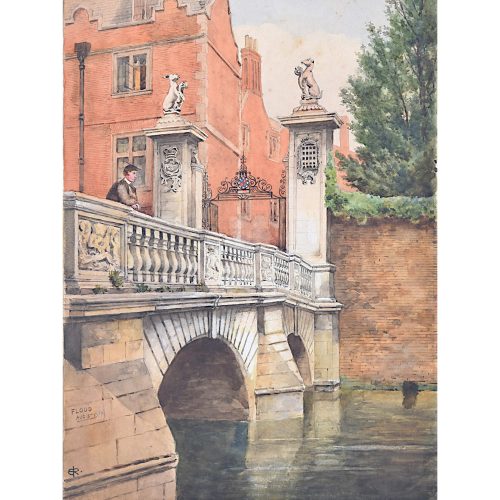
'ER' Monogrammist St John's College Cambridge, the Wren Bridge from the River Cam
Watercolour c. 1900 35x25cm A highly accomplished watercolour of the Kitchen Bridge at St John's College. The artist has clearly had a change of heart, and visibly moved the person standing on the bridge, bringing a sense of movement to what is otherwise a still painting. Moreover the richness of the colour he has chosen for the brickwork brings a further element of surprise to the viewer. If you are interested email info@manningfineart.co.uk or call us on 07929 749056. Condition: Mounted to board, the occasional tiny spot to the sky as visible in photograph. -
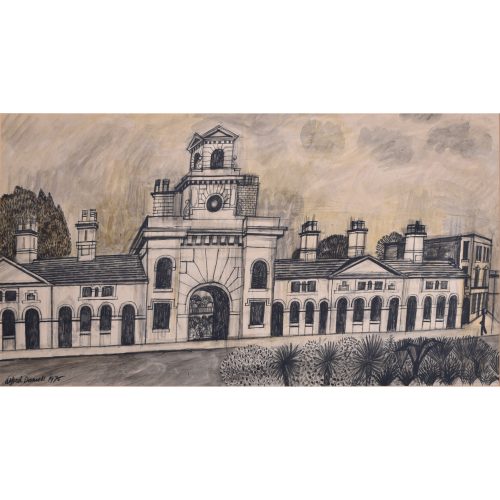
Alfred Daniels (1924-2015)
Almshouses Canning Circus Nottingham
Conte and wash, 1975 33x62cm Signed and dated 'Alfred Daniels 1975' Click here for biographical details and other works by the artist. If you are interested email info@manningfineart.co.uk or call us on 07929 749056. -
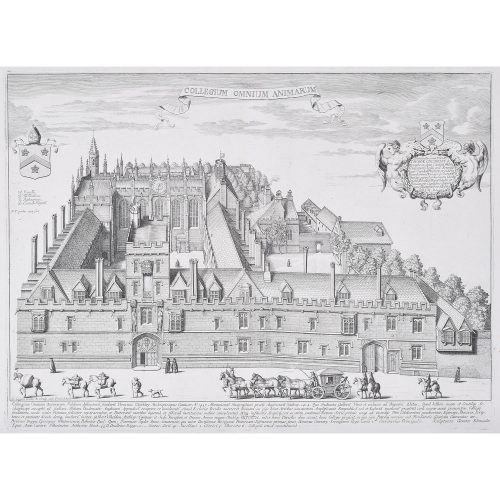
David Loggan (1634-1692) All Souls College, Oxford
Collegium Omnium Animarum Engraving (1675) 30x40cm If you are interested email info@manningfineart.co.uk or call us on 07929 749056. -
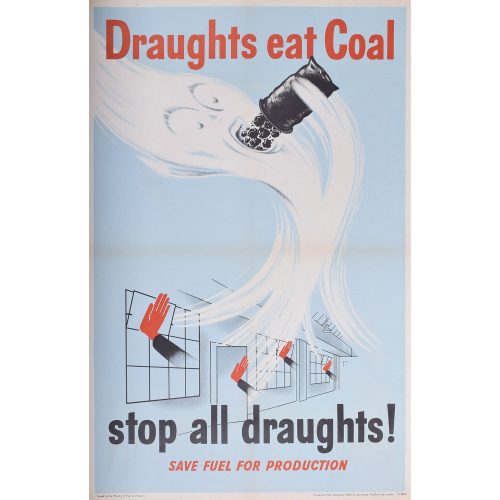
Anonymous
Draughts Eat Coal - Stop All Draughts! Save Fuel for Production
Lithographic poster 76 x 50cm Issued by the Ministry of Fuel and Power Printed for HM Stationery Office by J Weiner Ltd, London WC1 Fuel was needed for production of munitions and machinery, as well as to drive the machinery. The population was therefore exhorted not to waste fuel. Successful Home Front propaganda posters, as Fougasse proved, needed to amuse the watcher; cartoonists were accordingly highly regarded for this task. -

Clifford Ellis (1907-1985)
Abstract in Grey I
Gouache 21x12cm Provenance: the family of the artist, by descent. Click here for biographical details and other works by the artist. If you are interested email info@manningfineart.co.uk or call us on 07929 749056. -
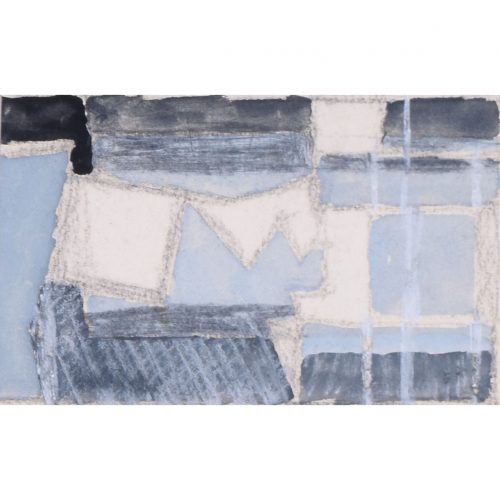
Clifford Ellis (1907-1985)
Grey Abstract
Gouache 10x18cm Provenance: the family of the artist, by descent. Click here for biographical details and other works by the artist. If you are interested email info@manningfineart.co.uk or call us on 07929 749056. -
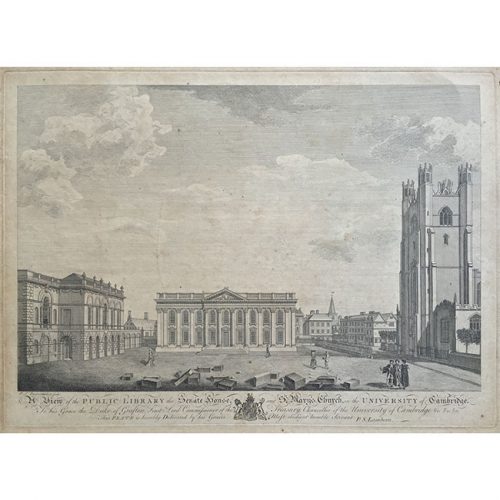
P S Lamborn (1722-1774)
A view of the Public Library, the Senate House and St Mary's Church and the University of Cambridge
Engraving, 1768 40x54cm If you are interested email info@manningfineart.co.uk or call us on 07929 749056. -
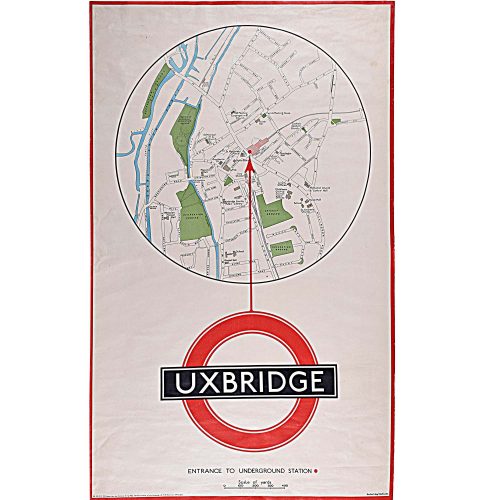
Uxbridge Station Poster c.1930 Printed by HMSO
Lithograph 100x62cm This four coloured lithograph was printed in extremely limited numbers for London Transport by HMSO. These maps detailed station entrances and were placed along the underground network to inform commuters exactly where they were in London. If you are interested email info@manningfineart.co.uk or call us on 07929 749056. Condition: Generally very good, slight bruising to the very edges in places, and a little touching in of the red border.

